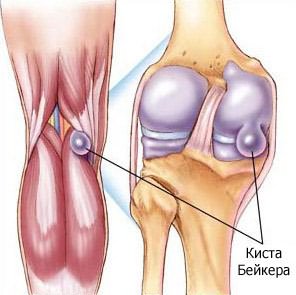Antipyretics for children are prescribed by a pediatrician. But there are emergency situations for fever when the child needs to be given medicine immediately. Then the parents take responsibility and use antipyretic drugs. What is allowed to give to infants? How can you bring down the temperature in older children? What medicines are the safest?
Acute ( TMJ) usually appears when it becomes inflamed ( ). may be unilateral or bilateral, acute or chronic ( lengthy). Quite often, this disease is accompanied by increased soreness when opening the mouth, difficulty eating and other symptoms. In the case of chronic pain, such disorders can cause serious harm to both the physical and emotional state of a person, so it is not recommended to postpone the treatment of this disease.
More often this disease is observed in children and in people of senile age. In the first case, this is due to the constant processes of growth of bones and teeth in the child's body, as well as increased risk joint injury during games. The elderly are more likely to experience various infectious and systemic inflammatory diseases. Men and women get sick with the same frequency.
Interesting Facts
- The temporomandibular joint moves whenever a person chews, swallows, or speaks ( that is, on average every 30 to 40 seconds).
- Every second person during his life at least once experienced pain or discomfort in the jaw joint.
- Movements in the mandibular joint can be carried out in three planes, due to the peculiarities of its structure.
Anatomy of the temporomandibular joint
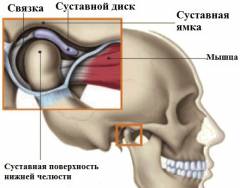 The temporomandibular joint is paired and is located at the junction of the lower jaw with the temporal bone of the skull. It also refers to combined joints, that is, movements in the left and right joints are always simultaneous and synchronous. Its main function is to ensure the mobility of the lower jaw.
The temporomandibular joint is paired and is located at the junction of the lower jaw with the temporal bone of the skull. It also refers to combined joints, that is, movements in the left and right joints are always simultaneous and synchronous. Its main function is to ensure the mobility of the lower jaw. The structural elements of the temporomandibular joint are:
- articular surfaces. The joint itself is formed by the articular surfaces of the lower jaw ( articular head) and mandibular ( articular) fossa of the temporal bone.
- articular capsule. The TMJ capsule is represented by a dense connective tissue. It surrounds the joint from the outside and limits the articular cavity.
- synovial fluid. The inner layer of the joint capsule is lined with endothelial cells that produce the so-called synovial fluid. It fills the joint cavity, ensuring the sliding of the articular surfaces relative to each other, as well as performing a protective ( antibacterial) function. The amount of synovial fluid in the joint cavity directly depends on the functional activity of the joint - with increasing loads, the rate of its formation increases, while with prolonged inactivity of the joint ( for example, when immobilized after) is decreasing.
- intraarticular disc ( cartilage). An important structural feature of the temporomandibular joint is the presence of a special fibrous cartilage between the articular surfaces. With its edges, this cartilage fuses with the articular capsule, dividing the joint cavity into 2 sections ( upper and lower).
- Connective device. In the region of the temporomandibular joint, three ligaments are distinguished - 1 large ( lateral ligament) and two smaller ones. Their main function is to limit the movements of the articular head - the lateral ligament prevents its excessive displacement backwards, while the small ligaments support the lower jaw. Also, this joint is connected by two ligaments to the malleus of the middle ear ( bone formation involved in the perception of sounds).
In the temporomandibular joint, 3 types of movements are possible:
- Opening and closing the mouth. These movements are carried out due to the displacement of the articular head of the lower jaw, while the articular disc remains in place. This occurs during speech and when chewing food.
- Advancement of the lower jaw. In this case, the head of the lower jaw is displaced along with the articular cartilage, that is, the movement is carried out in the upper part of the articular cavity.
- Lateral displacement of the jaw. During this movement, the head of the lower jaw from the side of rotation ( that is, in the joint towards which the jaw is displaced) rotates around its axis, while in the opposite joint, the articular head is displaced down and sideways. This movement is especially important when chewing hard, rough food.
Arterial blood to the joint is supplied by branches of the external carotid artery ( along the superficial temporal and other, smaller arteries). Venous blood flows into the venous network of the lower jaw and further into the jugular vein of the neck. Lymph outflow is carried out to the cervical lymph nodes, which is important for spreading with purulent inflammation of the joint.
Causes of inflammation of the temporomandibular joint
 Joint pain can occur for a variety of reasons. Depending on the cause of occurrence, they differ as pathological processes and approaches to the diagnosis and treatment of the disease.
Joint pain can occur for a variety of reasons. Depending on the cause of occurrence, they differ as pathological processes and approaches to the diagnosis and treatment of the disease. The cause of inflammation of the temporomandibular joint can be:
- mechanical injury;
- infection;
- systemic inflammatory diseases.
mechanical injury
An impact or fall can cause damage to any of the components of the joint, leading to characteristic clinical manifestations.Joint injury can cause:
- rupture of the joint capsule;
- rupture of the periarticular ligaments;
- crack / fracture of the articular surfaces of the bones;
- hemorrhage in the joint cavity.
Infection
When pathogenic microorganisms enter the joint cavity, an inflammatory process can also develop.Infection can enter the joint cavity in three ways:
- direct;
- contact;
- hematogenous ( through the blood).
In this case, infection occurs when the joint is injured, accompanied by a violation of the integrity of the joint capsule ( with a fracture of the lower jaw, with blows, stab and gunshot wounds). Microorganisms penetrating into the joint cavity can cause specific ( tuberculosis, syphilitic) or non-specific ( staphylococcal, streptococcal)inflammation.
contact route of infection
Contact infection of the temporomandibular joint involves the spread of bacterial agents from infected nearby tissues ( muscles, bones, ligaments, etc.).
The cause of hematogenous infection of the TMJ can be:
- lungs or intestines;
- purulent foci of any localization;
- (penetration and spread of pyogenic microorganisms in the blood).
Systemic inflammatory diseases
This group includes a number of rheumatic diseases characterized by the development of generalized ( systemic) inflammatory process in various organs and tissues. Under normal conditions, the human immune system is designed to protect the body from foreign infectious agents. However, in some diseases, its work fails, as a result of which immunocompetent cells begin to interact with the tissues of their own body, leading to their damage.Inflammation of the TMJ can be caused by:
Rheumatoid arthritis
This disease is characterized by damage to connective tissue throughout the body. The most obvious clinical sign at the same time, various joints are affected. The defeat of the temporomandibular joint in rheumatoid arthritis occurs in approximately 15% of patients.
The exact causes of the disease have not been established. A certain role in its occurrence is played by genetic predisposition and viral infections (virus, virus B and others). The essence of this disease lies in the fact that cell activation occurs in the joint cavities immune system (T and B-), which accumulate in the tissues of the articular cavity. A chronic inflammatory process develops, the outcome of which is damage and destruction of intraarticular components ( cartilage, articular surfaces of bones and other).
Systemic lupus erythematosus
Joint damage in systemic lupus erythematosus occurs in more than 90% of patients. The essence of this disease also lies in the disruption of the immune system, however, in this case, B-lymphocytes produce autoantibodies ( that is, immune complexes that attack the intracellular structures of the body's own cells), resulting in tissue damage. A distinctive feature is the fact that the deformation of the components of the articular cavity does not occur, and clinical manifestations can completely disappear after the cure of the underlying disease.
Reactive arthritis
This disease is characterized by non-purulent inflammation of the joints that occurs shortly after an intestinal or genitourinary infection ( after infection, and other microorganisms). The reason for the damage to the joints is that the structural components of some microorganisms and their toxins are similar to some tissues of the human body.
Once in the body, infectious agents come into contact with the immune system, as a result of which a number of protective reactions are launched aimed at identifying and destroying “foreign” agents ( antigens). However, since “foreign” antigens are similar to “self”, cells of the immune system also damage the tissues of their own body, including various components of the joints ( cartilage, ligaments, articular surfaces).
Gout
This disease is characterized by a metabolic disorder, as a result of which crystals begin to be deposited in the tissues of the body. There are many causes of the disease, but their essence boils down either to the increased formation of uric acid ( when eating a large amount of meat, when conducting antitumor treatment), or to a violation of its excretion by the kidneys. As a result of an increase in the concentration of uric acid in the blood, its salt ( urates) accumulate in various tissues, including joints, causing the development of an acute inflammatory process.
Symptoms of inflammation of the temporomandibular joint
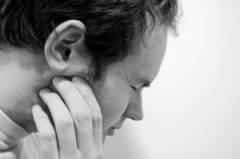 Regardless of the cause, TMJ inflammation always manifests itself with similar symptoms. However, when evaluating symptoms, clinical manifestations from other organs should also be evaluated ( damage to other joints, signs of infection, and so on) and the whole organism as a whole, in order to recognize and start treatment of systemic and infectious diseases in time.
Regardless of the cause, TMJ inflammation always manifests itself with similar symptoms. However, when evaluating symptoms, clinical manifestations from other organs should also be evaluated ( damage to other joints, signs of infection, and so on) and the whole organism as a whole, in order to recognize and start treatment of systemic and infectious diseases in time. As mentioned earlier, the inflammatory process in the joint can be acute or chronic.
Symptoms of acute inflammation
An acute inflammatory process is characterized by a pronounced tissue edema and hypersensitivity. nerve endings (what causes severe pain). In addition, exudate often accumulates in the joint cavity ( inflammatory fluid resulting from an increase in the permeability of blood vessel walls), further exacerbating the course of the disease.Acute inflammation of the temporomandibular joint can manifest itself:
- Pain. With inflammation of the joint, the pain is always sharp, sharp, stabbing or cutting. Pain is always aggravated by movement during speech, when chewing food, and so on), which can significantly affect the quality of human life ( usually patients cannot open their mouth more than 1 - 1.5 cm). Pain can also radiate spread, give away) to nearby organs and tissues of the face and head. Irradiation of pain is due to the fact that different parts of the soft tissues of the face are innervated by the same nerve ( trigeminal nerve). As a result, pain impulses emanating from the region of the temporomandibular joint can be perceived by the patient as pain in other areas.
- Swelling and redness of the soft tissues in the joint area. This symptom is characteristic of purulent arthritis, accompanied by the multiplication of pathogenic microorganisms in the joint cavity. In the focus of inflammation, a large number of inflammatory mediators are released. They cause the expansion of blood vessels, blood flow to the affected area increases, resulting in its reddening. At the same time, there is an increase in the permeability of the vascular walls, as a result of which the blood plasma leaves the vascular bed and impregnates the surrounding tissues, causing the development of edema.
- Local rise in temperature. An increase in temperature by 1 - 2 degrees compared to the surrounding tissues ( or with a symmetrical area of the other joint, if only one of them is inflamed) is also due to the expansion of blood vessels and the influx of more warmer blood to the site of inflammation.
- Feeling of fullness in the area of the joint. This sensation can be caused by both tissue edema and the accumulation of a large amount of exudate in the joint cavity.
- Hearing impairment. As a result of the spread of the inflammatory process to the tissues of the external auditory canal, it may narrow, as a result of which the patient may feel ear congestion and hearing loss on the side of the injury. In the case of an infectious nature of the inflammation, the infection can spread to the structures of the middle and inner ear, which can lead to more serious hearing impairment, up to complete deafness.
- Fever. Symptoms such as an increase in the body above 38ºС, pain and aches in the muscles, general and increased fatigue may indicate the presence of a systemic infection in the body, as well as purulent inflammation of the TMJ.
Symptoms of chronic inflammation
As the inflammatory process subsides, the amount of exudate in the joint cavity gradually decreases, but proliferative processes may develop ( that is, in the focus of inflammation, active cell reproduction and the formation of new tissues begin). The resulting tissues can compress the intra-articular structures, causing dysfunction of the joint.Chronic inflammation of the temporomandibular joint can manifest itself:
- Pain. The pain in this case is less pronounced and is described by patients as "aching", "pulling". Pain can be constant or appear only with a load on the joint ( while talking or eating). Joint function is also limited ( the patient can open his mouth no more than 2 - 3 cm).
- Stiffness of movements in the joint. Stiffness is especially pronounced in the morning or after a long ( few hours) joint inactivity. The development of this symptom is due to the compression of the articular components by proliferating cells. After several active movements, the joint “warms up”, as a result of which the feeling of stiffness may disappear.
- Cracking when moving the joint. The occurrence of a crunch or “click” during movement in the joint is due to the narrowing of the joint space and the convergence of the articular surfaces of the bones. Quite often, a crunch can be accompanied by increased pain.
- Moderate systemic manifestations of inflammation. Body temperature may be normal or slightly elevated ( up to 37 - 37.5ºС). The patient may complain of a feeling of weakness, increased fatigue.
- Hearing impairment. With the transition of an acute process to a chronic one, damage to the components of the ear may disappear on its own, however, various kinds of hearing impairment often persist.
Diagnosis of the causes of inflammation of the temporomandibular joint
Which doctor should be consulted for inflammation of the jaw joint?
Depending on the underlying cause, the treatment of inflammation of the temporomandibular joint is carried out by specialists from various fields of medicine. If the symptoms of inflammation interfere with a person's normal daily life, but do not pose an immediate threat to health and life ( that is, if the inflammation is not caused by trauma or injury to the joint), it is recommended to make an appointment with family doctor.After a thorough questioning and clinical examination, the doctor may suspect one or another cause of inflammation and, on the basis of this, refer the patient to the appropriate specialist.
Depending on the causes of arthritis, the following may be involved in the diagnosis and treatment process:
- Orthopedist and traumatologist - in case of damage to the bone, cartilage or ligamentous components of the joint.
- Dentist - with diseases of the teeth and oral cavity.
- Otorhinolaryngologist ( ENT doctor) – with diseases of the ear, throat, nose, paranasal sinuses.
- Infectionist - when detecting infectious and inflammatory processes in the body.
- Rheumatologist - if the cause of arthritis is a systemic inflammatory ( rheumatic) disease.
- Dermatovenereologist - in the presence of foci of infection in the head, neck, face or other parts of the body.
- Phthisiatrician - in cases of suspected tuberculosis infection.
- Neurologist - if you suspect damage / disease of the trigeminal nerve.
- assessment of clinical data;
- (UAC);
- determination of proteins of the acute phase of inflammation;
- determination of autoantibodies in the blood;
- determination of the level of uric acid in the blood;
- radiography of the mandibular joint;
- study of synovial fluid.
Evaluation of clinical data
If the appearance of pain in the joint was preceded by a mechanical injury or wound, then the diagnosis is beyond doubt. In other cases, the doctor must carefully examine the patient, evaluate all the available clinical manifestations and establish or suggest the cause of the inflammation.| Researched indicator | What does | Norm | Possible Changes in TMJ Arthritis |
| RBC concentration | are red blood cells that carry oxygen throughout the body. | Men
(M
)
:
4.0 - 5.0 x 10 12 / l. | A decrease in the number of red blood cells and a decrease in the level can be observed in severe forms of systemic lupus erythematosus, as well as in severe systemic pyoinflammatory diseases. |
| Women(AND):
3.5 - 4.7 x 10 12 / l. |
|||
| Total hemoglobin level | Hemoglobin is a complex of iron with heme pigment, which is part of red blood cells. It is this complex that is responsible for the binding of oxygen and its delivery to the tissues of the body. | M: 130 - 170 g/l. | |
| AND: 120 - 150 g/l. | |||
| Platelet concentration | are directly involved in the process of stopping bleeding. | 180 - 320 x 10 9 / l. | A decrease in platelet concentration can be observed in systemic lupus erythematosus as a result of the production of antiplatelet antibodies. |
| Leukocyte concentration | cells of the immune system are called, which protect the body from foreign infections. When infectious agents of any kind enter the body, leukocytes begin to actively multiply and fight them, as a result of which their total concentration increases. | 4.0 - 9.0 x 10 9 / l. | An increase in the concentration of leukocytes over 10 x 10 9 /l indicates the presence of an infection in the body. At the same time, a decrease in the total number of leukocytes can be observed in systemic lupus erythematosus, which is due to the formation of antilymphocyte antibodies. |
| Number of neutrophils | responsible for destroying pathogens. They absorb and digest small particles and structural components of destroyed bacterial cells. Normally, 2 forms of neutrophils are isolated in the blood - segmented ( mature, involved in processes) and stab ( young, released into the bloodstream from the bone marrow). | Segmented forms:
ESR can increase several times in both infectious and systemic inflammatory diseases. That's why evaluate this indicator needed in conjunction with clinical examination data and other analyses. |
|
| AND: 5 - 15 mm/hour. |
Determination of proteins of the acute phase of inflammation
The biochemical indicator is of particular interest for the diagnosis inflammatory diseases. Acute phase proteins are called special substances that are released into the bloodstream during any inflammatory processes in the body, and an increase in their concentration is directly proportional to the activity of the inflammatory process.Acute phase proteins
| Index | Norm |
| C-reactive protein | Not more than 5 mg/l. |
| Serum amyloid A | Not more than 0.4 mg/l. |
| Haptoglobin | 0.8 - 2.7 g / l. |
| A 2- globulin | (M): 1.5 - 3.5 g / l. |
| (AND): 1.75 - 4.2 g / l. | |
| ceruloplasmin | 0.15 - 0.6 g / l. |
| fibrinogen | 2 - 4 g / l. |
| Plasminogen | The level of activity in plasma is 80 - 120%. |
| lactoferrin | 150 - 250 ng / ml. |
| ferritin | M: 12 - 300 ng / ml. |
| AND: 12 - 150 ng / ml. |
Determination of autoantibodies in the blood
If an infectious cause of inflammation is excluded, it is recommended to more carefully examine the patient for the presence of systemic inflammatory diseases. To do this, a number of studies are being carried out, the purpose of which is to determine various autoantibodies in the patient's blood ( that is, immunoglobulins directed against the body's own tissues), characteristic of certain rheumatological pathologies.
If a systemic inflammatory disease is suspected, it is recommended to investigate:
- rheumatoid factor. It is formed in most patients with rheumatoid arthritis, as well as in some patients with systemic lupus erythematosus. It is an immune complex formed by abnormal ( structurally changed) and normal antibodies.
- antinuclear antibodies. This term refers to a complex of autoantibodies that bind to the nucleic acids of the cell nuclei, causing their destruction and cell death. This type of antibody is characteristic of patients with systemic lupus erythematosus, and also occurs in approximately 10% of patients with rheumatoid arthritis.
- Antiplatelet and antileukocyte antibodies. characteristic of systemic lupus erythematosus.
This study produced in cases of suspected gouty arthritis. Under normal conditions, uric acid is constantly formed in the body, but is immediately excreted in the urine, as a result of which its concentration in the blood is maintained at a certain level. The formation and deposition of uric acid crystals in tissues and joints is possible only with a prolonged and pronounced increase in the concentration of this substance in the blood ( more than 350 µmol/l in women and more than 420 µmol/l in men), which can be easily detected by a special biochemical study.
X-ray of the mandibular joint
The principle of this method is the transillumination of the temporomandibular region with X-rays. These rays freely penetrate the air, are slightly delayed ( absorbed) soft tissues of the body ( muscles, ligaments) and are almost completely absorbed bone formations, which allows you to examine the bones of the body for the presence of cracks, displaced fragments, and so on.X-ray sign of an acute inflammatory process is the expansion of the joint space ( spaces between two surfaces of articular bones), caused by tissue edema and accumulation of exudate in the articular cavity. With the transition of an acute process into a chronic exudate, it gradually resolves, and thinning is also often observed. articular cartilage resulting in a reduction in joint space.
The disadvantages of the method include relatively low accuracy ( simple radiography does not reveal microcracks, as well as minor deformations of the articular surfaces of bones), which is why the main indication for its use is the suspicion of a fracture or dislocation of the articular head of the lower jaw after injury.
CT scan
This is a high-precision research method that combines X-ray and computer technology. The principle of the method is as follows - the patient is placed in a CT scanner and lies motionless for several seconds. At this time, an X-ray machine rotates in a spiral around the examined area of the body, producing many pictures. After the procedure is completed, the information obtained is processed on a computer, as a result of which the doctor receives a detailed three-dimensional image of the joints and bones.This method allows you to identify microcracks, dislocations and subluxations of the articular head of the lower jaw, determine the presence of a fracture and the degree of displacement of bone fragments. The disadvantages of the method include radiation exposure and higher cost ( compared to conventional radiography).
Magnetic resonance imaging
The principle of this method is based on the phenomenon of nuclear magnetic resonance - if a certain tissue is exposed to a strong electromagnetic field for some time, after the cessation of exposure, the nuclei of atoms emit a certain energy, which is recorded by special sensors. Depending on the cellular composition, all tissues of the body react differently to the influence of an electromagnetic field, as a result of which it is possible to obtain a fairly clear and detailed image of all components of the joint.MRI can detect damage such as rupture of the capsule and ligaments of the joint. Also, with the help of this study, it is possible to identify minor damage to the articular surfaces of the temporal bone and lower jaw, observed in rheumatoid arthritis and other rheumatological diseases. In this case, there is no radiation exposure, so the only drawback is the high cost of the method, which significantly limits its use in everyday practice.
The study of synovial fluid
This study involves puncture ( piercing) joint cavity with a needle and taking a small amount of intra-articular fluid for the purpose of its further research in the laboratory. This procedure is associated with a risk of infection of the joint, therefore, it should be performed by an experienced specialist and only with sterile instruments.
Synovial fluid testing may reveal:
- Change color and transparency. Normal synovial fluid is clear, colorless or slightly yellowish. Its turbidity, the appearance of foreign suspensions and impurities, the detection of leukocytes, as well as staining in a different color usually indicates the addition of an infection.
- The presence of rheumatoid factor. Evidence in favor of rheumatoid arthritis or systemic lupus erythematosus.
- Uric acid crystals. Their presence allows confirming the diagnosis of gout.
- Blood cells. This indicates damage to the blood vessels and hemorrhage into the articular cavity.
First aid for acute pain in the temporomandibular joint
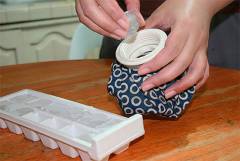 First aid may be needed in case of acute traumatic joint injury, as well as in case of infectious inflammation, when pain syndrome strongly pronounced. It should be noted right away that injury, severe pain or limited mobility in the mandibular joint requires qualified medical care therefore, the described measures can only be applied as a temporary measure before going to the doctor.
First aid may be needed in case of acute traumatic joint injury, as well as in case of infectious inflammation, when pain syndrome strongly pronounced. It should be noted right away that injury, severe pain or limited mobility in the mandibular joint requires qualified medical care therefore, the described measures can only be applied as a temporary measure before going to the doctor. First aid for pain in the mandibular joint includes:
- immobilization ( immobilization) the affected joint;
- use of cold;
- taking anti-inflammatory drugs.
Immobilization of the affected joint
Regardless of the cause, an acute inflammatory process is characterized by tissue edema, exudate formation in the joint cavity, and increased soreness of all structures of the affected area. Also, as a result of exposure to pro-inflammatory mediators, the sensitivity of nerve endings in the focus of inflammation increases, as a result of which, at the slightest movement, the patient feels severe pain.In addition, if inflammation developed after an injury, there is a high probability of a fracture. If at the same time the joint remains mobile, the bones or their fragments can damage nearby tissues, which will further increase pain and aggravate the patient's condition. That is why the first thing to do with acute pain in the joint is to immobilize it, that is, stop eating and reduce conversations with others to a minimum until the exact cause of the inflammation is established.
Use of cold
As mentioned earlier, in the focus of inflammation, there is an increase in local temperature, expansion of blood vessels and swelling of tissues. These adverse effects can be eliminated with the help of cold exposure to the area of the inflamed joint. Cold causes spasm constriction) blood vessels and increase the permeability of the vascular wall, thus preventing the leakage of fluid into the joint cavity and surrounding tissues. In addition, cooling reduces the sensitivity of nerve endings, which also effectively eliminates pain. It has been scientifically proven that the use of cold during the first minutes after injury to the joint reduces the severity of inflammation in the future and contributes to the speedy recovery of the patient.In order to cool the inflamed joint, you can use an ice bag, a bottle of cold water or just a cold compress which should be changed every 2-3 minutes). It is important to remember that contact of ice directly with the skin is highly undesirable, as this can cause hypothermia of the surrounding tissues. It is best to wrap the ice bag with a handkerchief or thin towel, then apply it to the inflamed joint for 5 to 15 minutes ( no more).
Taking anti-inflammatory drugs
It is possible to start self-medicated treatment of pain in the joint in case of ineffectiveness of the measures described above or simultaneously with them ( if the pain is particularly severe). To quickly relieve swelling and pain, drugs from the group can be used.NSAIDs used for pain in the temporomandibular joint
| Name of medication | Mechanism of therapeutic action | Dosage and administration |
| Diclofenac | They inhibit the activity of the cyclooxygenase enzyme in the focus of inflammation, preventing the formation of pro-inflammatory mediators. They have anti-inflammatory and action. They also inhibit the formation of cyclooxygenase in the area gastrointestinal tract, which leads to the development of a series side effects (, and so on). | To eliminate the pain syndrome, a single intramuscular injection 50 - 100 mg of the drug, after which they switch to taking tablet forms. Maximum daily dose should not exceed 150 mg. |
| Indomethacin | Intramuscularly at a dose of 60 mg 1-2 times a day. Maximum allowable duration intramuscular application- 2 weeks. | |
| Nimesil(nimesulide) | It has more pronounced anti-inflammatory and analgesic effects and at the same time has a weaker effect on cyclooxygenase outside the focus of inflammation ( i.e. causes fewer side effects than either). | Take orally 100 mg ( 1 tablet or 1 sachet dissolved in 100 ml of warm boiled water) 1 - 2 times per knock. The analgesic effect develops within 30-60 minutes and lasts for 6-8 hours. The maximum allowable duration of treatment is 2 weeks. |
Is surgery necessary for inflammation of the temporomandibular joint?
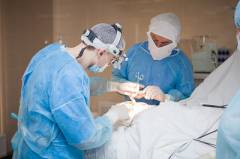 The operation is performed if it is the only possible method of treatment, and also if the risk of complications increases without surgery.
The operation is performed if it is the only possible method of treatment, and also if the risk of complications increases without surgery. The main indication for surgical treatment is purulent arthritis of the mandibular joint. In this case, we are talking about an infectious inflammation of the joint caused by pyogenic microorganisms ( , and others). The resulting pus fills the joint cavity, significantly disrupting its function. In addition, purulent arthritis can cause fusion and necrosis ( death) intra-articular components ( cartilage, articular surfaces of bones and so on), which will lead to a complete loss of joint function. Also, there is a high risk of transmission of infection to neighboring organs and tissues ( in the ear, in the neck, in the cranial cavity) or enter the bloodstream and spread throughout the body, which can lead to the death of the patient.
Preoperative preparation includes performing the necessary tests ( general analysis blood and, determination of the state of the blood coagulation system). The operation itself is performed under general anesthesia in a sterile operating room. After a skin incision and access to the joint, the joint capsule is opened, and the joint cavity is cleared of purulent masses and necrotic ( dead) tissues. The integrity of the intra-articular structures and the degree of spread of pus to neighboring tissues are also assessed. After completion of the operation, the joint cavity is drained ( that is, a thin rubber band or tube is installed in it, thanks to which the blood or inflammatory fluid accumulating in the joint will be released to the outside), after which the joint capsule and skin are sutured.
IN postoperative period the patient is prescribed:
- broad spectrum ( for example, ceftriaxone 1 gram once a day intramuscularly).
- Narcotic painkillers ( e.g. 1 ml of 1% morphine solution intramuscularly).
- Non-steroidal anti-inflammatory drugs ( , indomethacin)
- From 2 to 3 days after the operation, physiotherapy may be prescribed ( , dry heat, and others).
- Strict, including exclusively liquid food.
It is also worth noting that surgical treatment may be needed for traumatic inflammation of the joint, if as a result of the injury there was a fracture of the articular surfaces of the bones, rupture of the joint capsule or ligaments, and other serious injuries. Such patients in the postoperative period are prescribed long-term immobilization of the joint ( for a period of 1 - 2 to 4 - 5 weeks).
Treatment of post-traumatic inflamed temporomandibular joint
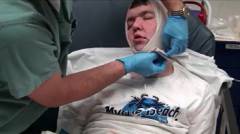 If inflammation of the joint is caused by a bruise or other minor injury, it can go away on its own without any consequences for the patient. However, more often without appropriate treatment, the acute inflammatory process does not subside or does not subside completely, turns into chronic inflammation and causes the development of complications. That is why if the pain and discomfort in the joint area does not go away within 2-3 days ( including against the background of taking anti-inflammatory drugs), it is recommended to consult a doctor as soon as possible.
If inflammation of the joint is caused by a bruise or other minor injury, it can go away on its own without any consequences for the patient. However, more often without appropriate treatment, the acute inflammatory process does not subside or does not subside completely, turns into chronic inflammation and causes the development of complications. That is why if the pain and discomfort in the joint area does not go away within 2-3 days ( including against the background of taking anti-inflammatory drugs), it is recommended to consult a doctor as soon as possible. In the treatment of post-traumatic inflammation of the temporomandibular joint, the following is used:
- immobilization;
- drug treatment;
- physiotherapy.
Immobilization
Immobilization as a first aid method for joint inflammation has been described previously. If, after the examination, the doctor revealed a fracture, or mandibular joint, this is an indication for a longer and more thorough immobilization ( after appropriate treatment - comparison of bone fragments, reduction of dislocation, and so on).Methods of immobilization of the mandibular joint
| Method name | Description | Photo |
| Soft chin sling | It is one of the simplest and easiest ways to immobilize the mandibular joint. Consists of a soft part ( slings), which is applied to the chin area, and two wide rubber bands that are wound behind the back of the patient's head and fixed one to the other there. | 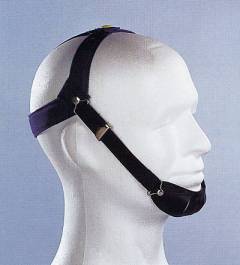 |
| Sling bandage on the lower jaw | A sling-like bandage can be made independently from improvised means ( from an elastic or regular bandage folded in a few words). From the corners of the sling should depart 2 strands on each side. The sling is set at the level of the chin, after which its upper ends are brought behind the neck ( below the ears) and fix ( tied up). The lower ends of the bandage are carried out in front of the auricles and fixed on the parietal region. | |
| Parieto-chin bandage | To apply a bandage, a wide bandage is used, tours ( turns) which are carried out alternately around the circumference of the head ( frontal to occipital region), then around the chin and occipital bone ( bypassing auricles behind) and around the chin and parietal bones (bypassing the auricles in front). Such a bandage is quite fragile and usually shifts after 1 to 2 hours after application. To prevent this, you can use an elastic bandage instead of the usual one. | 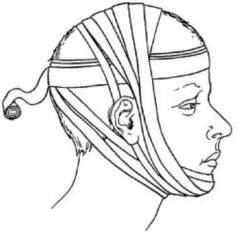 |
In addition to the described temporary methods of immobilization, permanent ones are also used ( long). They are used in the presence of fractures of the articular surfaces of the lower jaw or temporal bone, when for the union of the defect ( callus formation) need more time ( 4 – 5 weeks).
For the purpose of long-term immobilization are used:
- Various methods of intermaxillary ligature bonding ( that is, the teeth of the upper and lower jaws are fastened together with a wire). The procedure itself is performed local anesthesia.
- The imposition of dental splints that can be fixed to the teeth and other departments oral cavity (The procedure is also performed under local anesthesia.).
Medical treatment
The main goal of drug therapy is to eliminate the pain syndrome, as well as to prevent the progression of the inflammatory process.Drug treatment of post-traumatic inflammation of the mandibular joint
| Drug group | Representatives | Mechanism of therapeutic action | Dosage and administration |
| Diclofenac | The mechanism of action and methods of application have been described previously. | ||
| Indomethacin | |||
| Nimesil | |||
| Non-narcotic pain medications | Paracetamol | By inhibiting the formation of cyclooxygenase in the central nervous system, it reduces the sensitivity of pain centers in the brain, thereby reducing pain. | If it is impossible to take it through the mouth, it is introduced into the rectum in the form of rectal suppositories 2-4 times a day. The dose is determined by the age of the patient:
|
| Narcotic painkillers | Morphine | Acting at the level of the central nervous system, blocks the transmission of pain nerve impulses to the brain, and also reduces the psycho-emotional response to pain. | Intramuscularly 10 mg 4-6 times a day ( depending on the severity of the pain syndrome). |
| Tramadol | Synthetic drug, similar in structure to narcotic painkillers. Violates the transmission of pain impulses in the central nervous system, and also has a weak sedative effect. | It is administered intravenously or intramuscularly at a dose of 50-100 mg ( for adults). If the analgesic effect is insufficient, the injection can be repeated after 30-40 minutes. The maximum daily dose is 400 mg. Children are prescribed at a dose of 1 - 2 mg / kg. The maximum daily dose for children is 4-8 mg/kg. |
|
Physiotherapy
If the inflammation is caused by a bruised joint, physiotherapeutic procedures can be applied after 3-4 days. For more severe damage ( fractures, dislocations, rupture of the joint capsule or ligaments) the time of appointment of procedures is determined by the attending physician.Physiotherapeutic methods of treatment of post-traumatic inflammation of the mandibular joint
| Method name | Method Description and Assignment Rule |
| UHF therapy | The principle of the method consists in exposing tissues to an electric field of ultrahigh frequency. The energy emitted by this field is absorbed by the cells in the affected area, which leads to tissue warming, improved blood and lymph circulation, and normalization of nervous and endocrine processes. The positive effects of UHF therapy are:
|
| electrophoresis | The essence of this method is the combined use of direct electric current and various medicines. Once in the area of action of such a current, drugs begin to move from one electrode to another, thus penetrating deep into the tissues, which allows for the best therapeutic effect. Direct exposure to direct electric current causes:
|
| Phonophoresis with hydrocortisone | The principle of the method is similar to electrophoresis, only ultrasound is used instead of direct electric current ( high frequency sound waves). At the same time, hydrocortisone is applied to the surface of the skin in the area of inflammation ( steroidal anti-inflammatory drug) penetrates deep into tissues, providing anti-inflammatory and analgesic effects. The course of treatment includes 7-10 procedures, each of which lasts 5-15 minutes. |
| diadynamic therapy | The principle of the method consists in exposing human tissues to direct currents of various frequencies ( 50 to 100 hertz). At the place of application of such currents, recovery processes are activated on cellular level, the activity of the inflammatory process decreases, and the sensitivity of nerve endings in the focus of inflammation decreases, which causes an analgesic effect. To achieve the optimal therapeutic effect, 2 procedures should be performed ( 15 - 30 minutes each) 2 times a day. The course of treatment is no more than 10 procedures. If necessary, a second course can be prescribed no earlier than 2 weeks later. |
Treatment of inflammation of the temporomandibular joint due to rheumatic diseases.
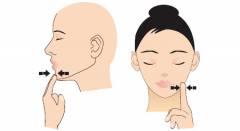 Treatment of arthritis in this case is carried out simultaneously with the treatment of the underlying disease.
Treatment of arthritis in this case is carried out simultaneously with the treatment of the underlying disease. For arthritis caused by rheumatic diseases, it is used:
- drug treatment;
- developing exercises.
Medical treatment
Prescribed drugs from various pharmacological groups, the purpose of which is to reduce the activity of the inflammatory process and prevent further damage to body tissues. The method of application and dosing regimen of drugs is determined by a rheumatologist individually in each case and depends on the nature and severity of the disease, the activity of the inflammatory process and other factors.Medical treatment for rheumatoid arthritis
| Drug group | Representatives | Mechanism of therapeutic action |
| Non-steroidal anti-inflammatory drugs | Diclofenac | The mechanism of action has been described previously. |
| Nimesulide | ||
| Celecoxib | It is an anti-inflammatory drug that blocks exclusively cyclooxygenase in the focus of inflammation. It has a pronounced anti-inflammatory effect, and also suppresses the formation of exudate and proliferation ( overgrowth) fibrous tissue of the joint. | |
| Steroid anti-inflammatory drugs | Prednisolone | They inhibit the activity of leukocytes, thereby reducing the activity of inflammatory processes in the body. Prevent the formation of exudate and restructuring of tissues in inflamed joints. |
| Methylprednisolone | ||
| Cytostatics | Methotrexate | They block the formation of leukocytes, thereby reducing the activity and severity of inflammatory processes and preventing their recurrence. |
| Leflunomide | ||
| Cyclophosphamide | ||
| Azathioprine | ||
| Sulfasalazine | ||
| Hydroxychloroquine | ||
| Monoclonal antibodies | infliximab | In the human body, these drugs bind and neutralize the so-called tumor necrosis factor, a biologically active substance involved in the development and maintenance of autoimmune and inflammatory processes. |
| Adalimumab | ||
| etanercept |
Development exercises
Most rheumatic diseases have an increased risk of ankylosis ( adhesions) of the affected joints, that is, impaired mobility in it. This is due to the growth of tissues in the joint cavity, which is observed during prolonged autoimmune and inflammatory processes.To prevent ankylosis of the temporomandibular joint will help a set of simple exercises that must be performed daily 3-4 times a day throughout the course of treatment. It is worth noting that it is recommended to start performing these exercises only after the acute inflammatory process subsides and the pain syndrome stops.
To prevent ankylosis of the mandibular joint, it is recommended to perform the following exercises:
- Lightly pressing the chin from below with your hand, you must slowly open your mouth, lowering the lower jaw as low as possible. After that, without stopping the pressure on the chin, you need to slowly close your mouth.
- Grasping the protruding part of the chin with your fingers, you need to slowly lower and raise the lower jaw, trying to push it down and backwards.
- Slightly pressing your fingers on the side of the chin, you need to move the jaw to the right and left. After that, you need to press on the chin on the other side and repeat the exercise.
- Pressing on the front edge of the chin ( pushing him back) you need to push the lower jaw as far forward as possible.
Treatment of inflammation of the temporomandibular joint due to infection
 Used to treat infectious diseases antibacterial drugs. Initially, broad-spectrum antibiotics are prescribed, which are active against a large number of different microorganisms. After identifying a specific causative agent of the disease, drugs are prescribed that most effectively fight this type of infection.
Used to treat infectious diseases antibacterial drugs. Initially, broad-spectrum antibiotics are prescribed, which are active against a large number of different microorganisms. After identifying a specific causative agent of the disease, drugs are prescribed that most effectively fight this type of infection. Drug treatment of arthritis caused by infection
| Drug group | Representatives | Mechanism of therapeutic action | Dosage and administration |
| Penicillins | Amoxicillin | Violate the formation of structural components of the cell wall of bacteria, which leads to their death. | Inside, regardless of the meal, with a glass of water. Children over 10 years old and adults are prescribed 500 mg ( 1 tablet) 3-4 times a day. |
| Benzylpenicillin sodium salt | Intramuscularly or intravenously, 1 to 2 million units of action ( ED) 4 times a day. | ||
| Tetracyclines | Tetracycline | Penetrating into bacterial cells, drugs disrupt the synthesis of intracellular components responsible for division processes ( breeding). | Inside, 250 - 500 mg every 6 hours. |
| Doxycycline | Intravenously, drip, dissolving 100-200 mg of the drug in 250-500 ml of 0.9% sodium chloride solution. | ||
| Anti-tuberculosis drugs | Streptomycin | Violates the activity of intracellular components of Mycobacterium tuberculosis, preventing their further reproduction. | Intramuscularly at a dose of 1-2 grams per day ( in 1 - 2 doses). The course of treatment is at least 3 months. |
| Isoniazid | It inhibits the synthesis of structural components of the cell wall of Mycobacterium tuberculosis. | Inside, after meals, 200 - 300 mg 3 times a day. The treatment is long. | |
| Antifungal drugs | Nystatin | Slows down reproduction and leads to the death of pathogens. | The drug is taken orally, 3-4 times a day.
|
| Fluconazole | It blocks the activity of the enzyme systems of pathogenic fungi, which leads to their death. | inside. The initial dose is 400 mg 1 time per day, after which they take 200-400 mg every day. |
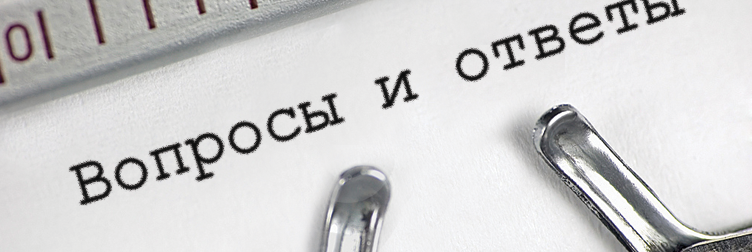
What are the complications and consequences of inflammation of the jaw joint?
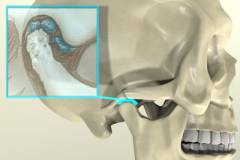 Prognosis and consequences for inflammation ( arthritis) of the mandibular joint is largely determined by the cause of its occurrence, as well as the timeliness and adequacy of the treatment. With the right approach, the disease can pass without a trace in a few days. At the same time, in the absence of treatment, formidable, often irreversible complications can develop.
Prognosis and consequences for inflammation ( arthritis) of the mandibular joint is largely determined by the cause of its occurrence, as well as the timeliness and adequacy of the treatment. With the right approach, the disease can pass without a trace in a few days. At the same time, in the absence of treatment, formidable, often irreversible complications can develop. For the treatment of inflammation of the mandibular joint is used:
- Anti-inflammatory herbal collection. To prepare the collection, take 20 grams of black elderberry flowers, 80 grams of birch leaves and 100 grams of willow bark. All ingredients are crushed and thoroughly mixed, after which 4-5 tablespoons of the collection are poured with 1 liter of boiling water and infused for 2-3 hours. It should be taken 3-4 times a day, 100 ml ( half a glass) before eating. In addition to anti-inflammatory, it also has analgesic and antibacterial effects.
- Burdock root infusion. To prepare the infusion, 1 tablespoon of chopped root should be poured with 400 milliliters of boiling water and infused for 2 to 3 hours. Strain thoroughly and take 1 - 2 tablespoons 3 - 4 times a day. It has anti-inflammatory and analgesic effects.
- Infusion of yarrow. Yarrow also has a pronounced anti-inflammatory effect. To prepare the infusion, 2 tablespoons of dry chopped herbs are poured with 200 milliliters ( 1 glass) boiling water. After cooling, filter and take 50-100 ml 3-4 times a day.
- Infusion of fragrant hernia. The fresh herb of this plant has a pronounced antibacterial and anti-inflammatory effect. To prepare the infusion, 1 tablespoon of chopped herbs is poured into 500 ml of boiling water and infused for an hour. After cooling, the infusion must be filtered and taken 50-100 ml 3 times a day. This recipe is especially effective for inflammation caused by infection or rheumatic diseases.
- Propolis tincture. It has a pronounced analgesic and anti-inflammatory effect. 100 grams of propolis should be poured with 500 ml of vodka and infused in a dark place at room temperature. After 2 - 3 weeks, the tincture must be carefully filtered and taken orally 10 - 20 drops 2 times a day.
Is there an effective prevention of inflammation of the temporomandibular joint?
 Specific preventive measures aimed at preventing inflammation of the mandibular joint have not been developed. The only effective method of prevention is the prevention and timely elimination of the causes that can lead to the development of the disease.
Specific preventive measures aimed at preventing inflammation of the mandibular joint have not been developed. The only effective method of prevention is the prevention and timely elimination of the causes that can lead to the development of the disease. Inflammation of the temporomandibular joint can be caused by:
- Trauma. When traumatizing the components of the joint ( fracture of the articular bones, bruising of soft tissues and so on) an inflammatory process develops, characterized by tissue edema, severe pain and dysfunction of the joint. As a result of the release of certain biologically active substances in the focus of inflammation ( serotonin, histamine, bradykinin and others) there is an expansion of blood vessels and the release of liquid plasma from the vascular bed. inflammatory fluid ( exudate) can accumulate in the joint cavity, increasing pressure on edematous tissues and further damaging them.
- Infection. Infection can enter the joint cavity in various ways ( when a joint is injured, when bacteria spread from nearby or distant foci). Infection of the joint is also accompanied by the development of an inflammatory process with all the adverse effects described earlier. In addition, when infected with pyogenic microorganisms ( e.g. staphylococci) the progression of the purulent-inflammatory process can lead to the destruction of intra-articular structures, which will lead to an irreversible dysfunction of the joint.
- Rheumatic diseases. Rheumatic diseases are characterized by excessive activity of the human immune system, resulting in the development of systemic inflammatory reactions that damage various tissues of the body ( joints first.). Also, in some diseases of this group, malfunctions occur in the immune system, resulting in damage to the tissues of the body by its own immune cells.
- Treat injuries promptly. Immediately after the injury, a cold compress or ice should be applied to the joint area. If needed, anti-inflammatory drugs can be taken for example, nimesil at a dose of 100 mg). If after 1 - 2 days the pain has not gone away, it is recommended to contact a traumatologist or orthopedist.
- Treat in a timely manner infectious diseases. Even if the source of infection is far from the joint, infectious agents can enter the bloodstream and spread throughout the body. That is why, when a bacterial infection is detected, it is necessary to start taking antibacterial drugs as soon as possible. You should also follow the duration of treatment prescribed by your doctor. If you stop taking antibiotics immediately after the disappearance clinical manifestations diseases - there is a high probability that some of the pathogenic bacteria will not die, but will remain in various tissues of the body, which can lead to a relapse ( re-aggravation) infections.
- Timely and adequately treat rheumatic diseases. Treatment of systemic inflammatory diseases should be prescribed by a rheumatologist after a thorough examination of the patient, taking into account the individual characteristics of the patient and the course of the disease. Self-medication is often ineffective, and can also lead to the development of a number of dangerous complications.
Is it possible to cure inflammation of the mandibular joint at home?
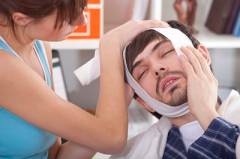 Arthritis treatment ( inflammation) of the mandibular joint can sometimes be carried out at home. However, it is worth remembering that often the cause of inflammation can be another, much more formidable disease or pathological condition. That is why, in case of ineffectiveness of self-treatment, as well as in case of deterioration of the patient's condition, it is necessary to consult a doctor as soon as possible.
Arthritis treatment ( inflammation) of the mandibular joint can sometimes be carried out at home. However, it is worth remembering that often the cause of inflammation can be another, much more formidable disease or pathological condition. That is why, in case of ineffectiveness of self-treatment, as well as in case of deterioration of the patient's condition, it is necessary to consult a doctor as soon as possible. The cause of inflammation of the temporomandibular joint can be:
- injury;
- infection;
- rheumatic diseases ( rheumatoid arthritis, systemic lupus erythematosus, gout and some others).
For the treatment of arthritis of the jaw joint after an injury, it is necessary:
- Immobilize the joint. It is recommended to talk as little as possible, and also to exclude the intake of rough and hard foods that require thorough chewing.
- Apply a cold compress. Exposure to cold reduces the severity of inflammation in the joint, reduces tissue swelling, reduces the risk of complications and speeds up the healing process.
- Eliminate pain. Non-steroidal anti-inflammatory drugs (NSAIDs) may be prescribed for this purpose. e.g. nimesulide 100 mg every 6 to 8 hours), which can be bought without a prescription at any pharmacy.
Treatment of infectious inflammation of the mandibular joint is carried out with the help of antibiotics. The patient can take them on their own at home, however, the doctor should prescribe these drugs after comprehensive survey. Anti-inflammatory drugs may also be used to relieve pain.
The treatment of rheumatological diseases consists in the use of various medications ( , immunosuppressants and others), which by themselves can give rise to a number of adverse reactions. That is why the treatment should be carried out under the supervision of a specialist, the patient must strictly follow the instructions of the rheumatologist and regularly take all the tests prescribed by the doctor.
What to do in this case, the doctor will tell you. This condition significantly worsens the quality of life, such patients turn to surgeons, dentists, traumatologists for treatment. The doctor can help immediately if there was a dislocation, or treatment can be delayed for a long time.
The causes that caused the symptoms of pain are as follows:
- The presence of a fracture in the bone structure resulting from a direct blow to the jaw, in accidents, in an accident. In all these moments, there is a mechanical effect on the jaw bones. In this case, the upper and lower jaws can be broken separately or together. The fracture can be direct or reflected, single or multiple, with the presence of bone fragments, undisplaced, open and closed. Symptoms of a fracture are manifested by soreness in the organ, swelling appears, and motor functions are impaired.
- Infection with an infectious disease leading to osteomyelitis. Pathology is manifested by an inflammatory process in all parts of the bones. The infection enters the focus either through blood or through infection of the pocket located between the tooth and gum. The most common pathogens are Staphylococcus aureus, anaerobes, streptococci. If the pain in the jaw joint is throbbing, accompanied by a headache and fever, then the likelihood of developing osteomyelitis is high. Treatment of the disease consists in detecting the affected tooth and the gums reddened around it, opening the focus to remove pus. Then, for several days, manipulations are carried out to drain it, a course of antibiotics with symptomatic therapy is prescribed. In such patients, in the general blood test, a shift of the leukocyte formula to the left and an increased erythrocyte sedimentation rate are observed. The patient's condition can be mild, moderate or severe.
- Odontogenic factor - when pain in the joint, in the jaw occurs after the appearance of pathology of the teeth and gums. These conditions include caries that has spread to the deep parts of the tooth with the nerve, with damage to the pulp, suppuration of the tissues around the teeth. Painful sensations intensify at night, are pulsating in nature. The patient feels pain in the root of the tooth, the symptoms extend to the corresponding jaw. The doctor, upon detection of an affected tooth, removes it, sanitizes the focus. However, often the consequences of this disease affect the trigeminal nerve of the face, the damage is characterized by a feeling of numbness of the lips, a decrease in masticatory muscle tone.
- Inflammation of the artery of the face - a pathological condition, accompanied by a burning sensation, spreads to the chin, jaw joint to the lips and nose. In some cases, the pathology captures wider areas of the face, reaching the corners of the eyes. The disease is diagnosed on a special basis - soreness is localized at the site of the inflection of the facial artery in the region of the lower jaw.
- Functional disorders of the joint of the jaw and temple. In this case, the jaw joint hurts along with the temple, cheek and forehead. The patient is unable to open his mouth, at the slightest movement there is a click. The causes of violations may be malocclusion or the development of inflammation in this area, myofascial syndrome in the masticatory muscles, the occurrence of osteoarthritis in the joint. Therefore, if the question arises why the jaw hurts, it is necessary to exclude the connection of pain with the joint. To do this, you should consult a doctor, undergo a diagnosis and start the right treatment.
- Inflammatory diseases of the cranial nerves (nerves of the skull) can cause pain. Most often, this condition is observed with trigeminal neuralgia, while the pain is burning in nature, manifested by sudden attacks. The pain is more pronounced directly in those areas where the inflammation of a certain branch of the nerve is pronounced. Characteristic for this disease is the absence of clinical manifestations in the evening and night periods. The lower jaw is not affected, the localization of pain is common only on the location of the branches.
- With inflammation of the superior laryngeal nerve, an unpleasant sensation occurs in the region of the larynx, thyroid gland and under the tongue. The spread of pain is wide enough: from the face and ear to the shoulders and chest. In addition, the patient is concerned about coughing, hiccups, profuse salivation. Pain is provoked by swallowing, blowing your nose, coughing, head movements. For therapy, some groups of drugs are used, local anesthesia is performed, in rare cases the nerve itself is cut.
- Sometimes jaw joints hurt with neuralgia of the glossopharyngeal nerve. The pain can spread to all areas of the face, ears and even the tonsils. To reduce discomfort, the patient bends his head in the direction of pain. If you press on the mandibular angle, the pain intensifies.
- With an inflammatory process in the ear node, a person is tormented by severe burning pains of a paroxysmal nature. The duration of each attack is about an hour. The pain extends to the jaws and teeth. The Eustachian tube contracts, resulting in clicking sounds in the ears. Eating hot or cold food can provoke or increase soreness. To correctly diagnose this nosology, use the method of finger pressure on the area between the mandibular joint and the external auditory canal. Wherein unpleasant symptoms intensify.
- Migraine. Such a condition in some situations may be accompanied by paroxysmal pain lasting several hours in a row. The sensation spreads to the region of the upper jaw with the capture of the oral cavity and ear. Then gradually "spreads" all over the face. If you press on the branching of the external carotid artery, the signs intensify. The same symptom is observed with a tumor process, with a stratified carotid artery and with inflammation of the temporal joint.
- Bone sarcoma. It is a malignant tumor of the bone, its occurrence among jaw tumors is more than 20%. With this disease, deforming changes in the bone tissue occur, severe constant pain spreads from the jaws all over the face, some areas of the face become numb.
Diagnosis of diseases
If you experience any discomfort in the area of the lower or upper jaw, you should contact medical institution, where the doctor will determine in which area there is a lesion. The patient is examined by dentists, surgeons, traumatologists, otorhinolaryngologists. Next, a laboratory and instrumental examination is prescribed: a general blood test to determine the inflammatory process, an X-ray examination, which helps to find the cause of the pain, if necessary, carry out computed tomography and MRI. If a patient is suspected of having an oncological pathology, then an analysis is carried out for tumor markers. If you suspect a lesion of the vessels of the head, use ultrasonography with doppler.
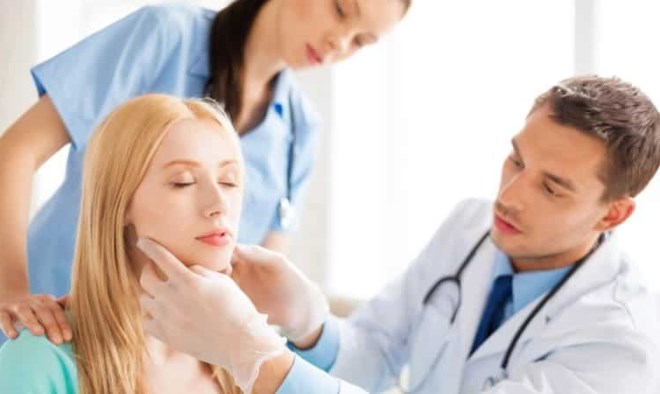
If there is pain, you should contact a specialist for help as soon as possible. However, if immediate medical attention is not possible, pain symptoms can be alleviated at home. For this, analgesics are used. medicines, locally use cold lotions, try to reduce the load on the jaw, for this they use food crushed on a blender or grater. All this is temporary in nature. In any case, qualified medical assistance is needed.
In case of violations of the function of the jaw joint, anti-inflammatory drugs are used, reduce physical activity to the organ. If one or another neuralgia became the cause of pain, a course of conservative treatment prescribed by a doctor is carried out. With its ineffectiveness, surgical intervention is performed - the nerve is cut.
In case of vascular disorders, therapy is carried out by narrow specialists, the method of treatment is conservative. The pain syndrome is eliminated by taking anesthetic drugs that allow you to relax the muscles, steroids are injected directly into the joint. Hormones not only eliminate pain, but also significantly reduce swelling. However, among the serious side effects- the occurrence of osteoporosis, thinning of the bone, eventually leading to the destruction of bone tissue. Locally, contrast compresses are widely used, which are applied to the joints with the mouth open. It is convenient to add an anti-inflammatory component to the compress. If the inflammation is not strong, relaxing exercises of the facial muscles are performed.
For the treatment of mechanical damage, insulating bandages are used on the jaw to reduce the load. A sparing liquid diet is prescribed so that the patient does not chew food, but only swallows crushed pieces.
In parallel with this, complex vitamins and minerals are prescribed for better bone fusion. After the restoration of bone structures, the patient must avoid serious stress, because relapses are possible.
Preventive actions
Prevention after diseases that caused pain in the jaw is aimed at reducing the load on the joints, eating soft foods and taking calcium supplements and chondroprotectors. In addition, hypothermia or overheating must be avoided. It is necessary to regularly visit the dentist's office, carry out the rehabilitation of carious foci in time and monitor the condition of the oral cavity. If you experience discomfort or sounds, you should immediately contact the hospital or clinic for timely treatment and to avoid complications.
All materials on the site are verified by practicing rheumatologists, but are not a prescription for treatment. If necessary, consult a doctor for an examination!
Pain in the jaw joint is one of the most common. Patients often complain of pain when chewing, moving the jaw. There are many reasons for these symptoms. To help the patient, you need to correctly diagnose and find out the cause of the pain.
The temporomandibular joint (TMJ) in the human body is considered one of the most used and mobile. It is responsible for opening and closing the jaw, so it almost always works when people talk, chew, yawn, etc.
Diseases associated with damage to the jaw joint are very common. A huge number of patients suffer from pain during jaw movement, according to statistics, about 40% of the population has experienced discomfort in the TMJ area at least once. However, not everyone seeks medical help, people do not attach serious importance to pain in the temporomandibular joint and usually self-medicate.
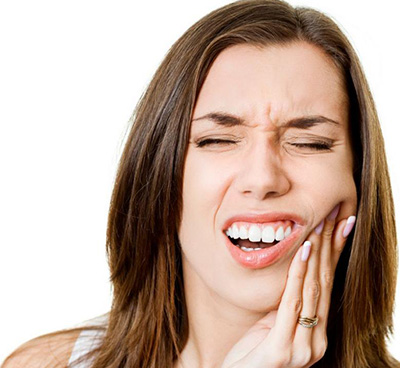
Why does the jaw joint hurt?
There are many causes of joint pain, the most common are:
- jaw injuries - fractures, bruises, muscle strains, etc .;
- inflammatory and infectious diseases (purulent parotitis, furuncle, abscess, arthritis, osteomyelitis, purulent otitis media and etc.);
- wearing dentures;
- malocclusion;
- endocrine diseases;
- pathology peripheral nerves and vessels;
- tumors;
- bad habits (clenching teeth, biting nails, opening bottles with teeth, etc.).
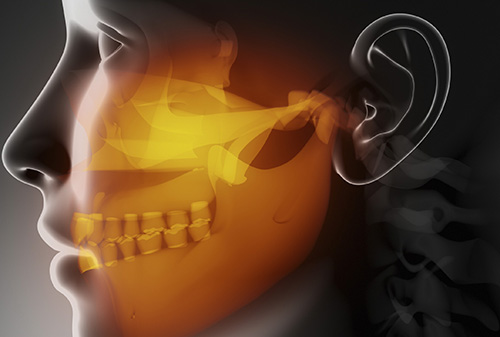
Types of TMJ diseases and main symptoms
When the maxillofacial joint hurts, depending on the cause of the disease, the following symptoms may additionally be observed:
- a feeling of congestion in the ears;
- enlarged lymph nodes under the jaw;
- dizziness and migraine;
- crunch when moving the jaw;
- spasms in the muscles of the face, etc.
Important! When the jaw joint hurts near the ear, this may be a signal for the development of a complication of a dental disease (development of arthritis, arthrosis, etc.).
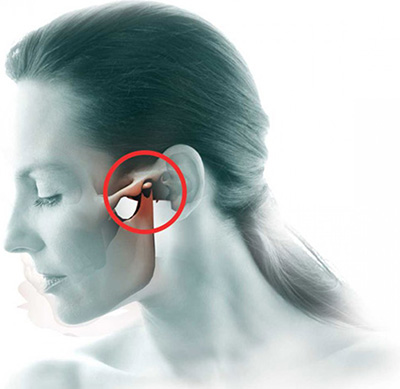
With TMJ diseases, patients are not only concerned about pain in the jaw, a common symptom of inflammation is ear pain.
Pain in the temporomandibular joint area indicates the development of some kind of disease or pathology, the most common cases are:
- Osteomyelitis - Purulent inflammation of the jaw joint. The main symptoms are severe jaw pain, swelling, fever, inflammation of the lymph nodes. The appearance of osteomyelitis in most cases is caused by caries or pulpitis, therefore, when examining the jaw, patients often complain of toothache. Osteomyelitis is a serious disease that requires immediate medical attention.
- Temporomandibular joint dysfunction - a consequence of endocrine diseases and psycho-emotional shocks, stress, trauma, malocclusion, prosthetics, etc. Sometimes TMJ dysfunction can be caused by congenital underdevelopment of the articular head. Signs of the disease: facial asymmetry, pain when chewing in the ear and temple, inability to smoothly open the mouth, swelling, characteristic crunch when moving the jaw, fatigue when chewing, etc.
- Arthritis. Symptoms: swelling and pain of the joint, clicking when the jaw moves near the ear, limitation of motor activity, etc.
- Arthrosis. Acute pain occurs with a strong opening of the mouth, clenching of teeth and chewing. Often the disease is accompanied by a crunch in the jaw joint.
- joint dislocation. Pathology develops as a result of muscle disorders, manifested by a displacement of the head and disc of the jawbone, the inability to close the mouth, a characteristic sound when moving the jaw, etc.
Important! Sometimes the temporomandibular joint hurts after the installation of dentures. Pain in this condition is considered a variant of the norm, since the joint is simply not used to the presence of a "foreign" object in the mouth. If the discomfort does not go away for a long time, you should consult a doctor.
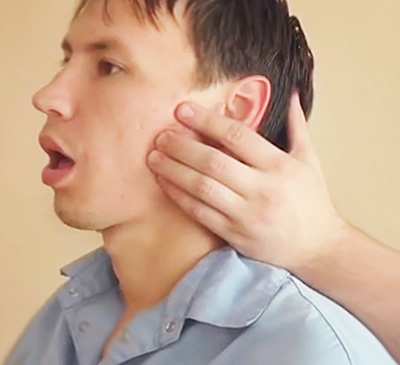
How to treat?
If the jaw joint hurts, you need to seek medical help. In the process of diagnosis and treatment of the disease, depending on its cause, various specialists can participate - dentists, orthopedists, rheumatologists, infectious disease specialists, neurologists, otolaryngologists, etc.
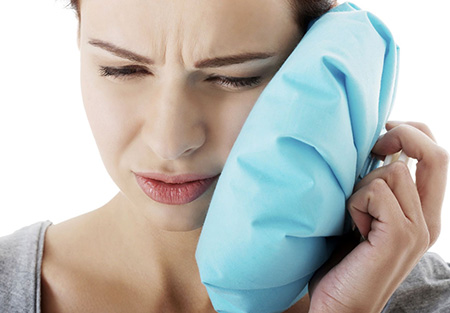
To establish the cause of pain in the temporomandibular joint, a patient is interviewed, his condition is assessed and anamnesis is taken. Diagnostics includes the following studies:
- determination of the amount of uric acid in the blood serum;
- radiography of the temporomandibular joint;
- analysis of samples of synovial fluid;
- MRI, etc.
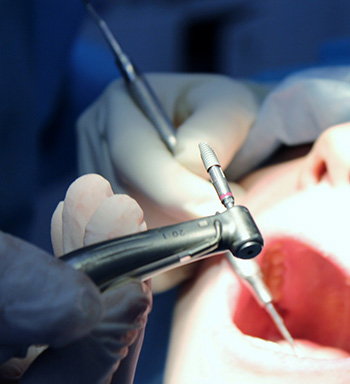
If the pain is a complication of a dental disease, the patient is treated by a dentist. Caries is a common cause of infection of the body and inflammatory diseases.
Often diseases of the jaw joint take place in acute form Therefore, providing the patient with emergency medical care is the first step to recovery. Patients with acute pain in the TMJ are shown complete rest, immobilization of the affected joint, application of cold.
Drug treatment depends on the cause of the pain, for example, with inflammation of the jaw joint, the patient is prescribed non-steroidal anti-inflammatory drugs and painkillers (Nimesil, Diclofenac, Ibuprofen, etc.). At infectious lesion joints are prescribed antibiotics, to relieve tension in the muscles - psychological relaxation drugs, to correct the bite - special prostheses, acrylic devices.
Physiotherapy effectively fights diseases of the jaw joints, patients are prescribed a course of electrophoresis, UHF, diadynamic currents, etc.
Important! Patients with TMJ inflammation and other joint diseases should not open their mouth wide and eat solid food. To immobilize a damaged joint, doctors recommend wearing a chin sling or chin bandage, using dental splints, etc.
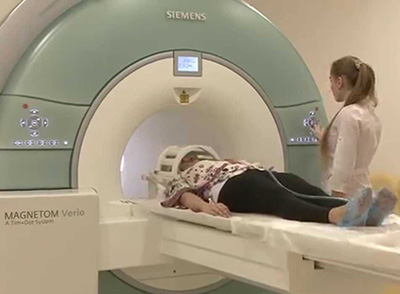
If conservative therapy does not help - resort to surgical treatment. Most often, operations are performed after serious joint injuries or with purulent.
Whatever caused the pain in the TMJ, be sure to consult a doctor. Self-medication with such a pathology is ineffective and threatens the development of complications.
Co-author of the material: Dmitry Ulyanov - orthopedic rheumatologist with 23 years of experience, doctor of the first category. Engaged in the diagnosis, treatment and prevention of all diseases of the joints and connective tissue. He has a diploma in Rheumatology, studied at the Peoples' Friendship University of Russia.
Many people learn about the existence of the jaw joint only when pain appears in it: usually it occurs when chewing, yawning and simply opening the mouth. Such pain occurs in medical practice quite often, can be due to many reasons and should not be ignored, as it is fraught with the appearance pathological changes in the temporomandibular joint. Making an appropriate diagnosis and deciding what treatment to give and what to do should be left to the physician.
Symptoms
Since the jaw joint itself does not have nerve endings, pain in it usually manifests itself rather in the muscles surrounding it. For example, painful sensations can occur when pressure is applied near the ear, or it can appear in the neck or in the shoulder blades.
Often, pathologies of the temporomandibular joint manifest themselves as a headache in the back of the head or temples, as well as tinnitus.
But the most common symptoms of problems are clicking in the area of the jaw joint when opening the mouth (which is heard even by others), and a crunch in it during mechanical movements of the jaws. All this indicates that the joint has shifted, and the muscles supporting it are experiencing excessive and unnatural tension, which can eventually lead to its blocking.
Causes
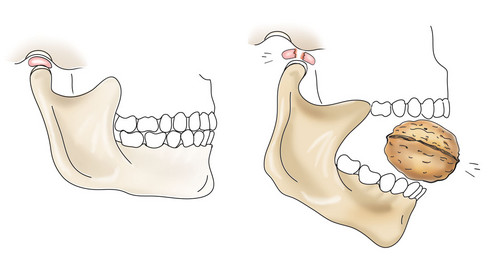
Today, pain in the jaw joint is becoming more common, and in people of all ages, i.e. there is a kind of negative trend. This may be due to:
- Microtraumas - due to accidentally opening the mouth too wide, blows, joint dislocation of varying severity and destruction of bone tissue can occur. Such injuries are often accompanied by jaw numbness;
- Malocclusion - in this case, the person automatically redistributes the load on the jaw, due to which the joints begin to deform and collapse;
- Neuralgia - disorders in the functioning of the nervous system and brain. So, it can be a lesion of the upper laryngeal nerve or glossopharyngeal nerve, etc.;
- A history of arthrosis and arthritis;
- A sharp tension in the muscles of the mouth while chewing food;
- Errors in surgical intervention in the oral cavity - at the dentist, etc.;
- Violations of the blood supply to bone and cartilage tissues in the mouth;
- Infectious diseases of the oral cavity;
- Inflammatory diseases of the ear.
But the most common cause of pain in the jaw joint is the thinning of the surfaces of the temporal bone and lower jaw. Sometimes chronic pain in the jaw or near the ear speaks of benign or malignant tumors.
Treatment
In order for a correct diagnosis to be made and necessary treatment, you can contact a dentist, neurologist or surgeon.
The dentist will check whether there are affected teeth in the oral cavity, whether there are any displacements and, in general, malocclusion, and if necessary, immediately determine what needs to be done next and begin treatment.
The rest of the medical problems will be identified by special diagnostic tools, neuropathologists and surgeons - they will also refer to other narrow specialists, if necessary. Treatment for pain in the jaw joint area may include the following:
- orthodontic bite correction, prosthetics;
- error correction surgical intervention, if there was one;
- physiotherapy treatment;
- reception medicines;
- acupuncture activities.
Also, a specialist can prescribe wearing an articular splint at night, which will relieve myofascial pain syndrome. In addition, special caps are used, limiters for opening the mouth, palatine, bite plates, etc. But whatever the prescribed treatment, it is important to comply with the whole range of prescribed actions and not delay its implementation. If this is not done, there will be consequences.
Complications
A displaced disk of the temporomandibular joint provokes a restructuring of the articular surfaces, which is categorically unacceptable for them, since the joint cavity begins to fill with coarse connective tissue because of this. Also, problems can arise when opening the mouth - it will just become very difficult.
In addition, there may be a grinding of teeth, leading to their abrasion and sensitivity. Ear congestion can lead to partial or complete hearing loss in it, and head pain can approach the strength of a migraine and occur more often. And constant increased tension in the muscles around the mouth can lead to such serious consequences as:
- dizziness;
- Back pain;
- Sleep disturbances and disorientation in space;
- Violations in the work of the eye muscles and blurred vision;
- Eye pain, photophobia;
- Depression.
Therefore, it is important to try to prevent the occurrence of pathologies of the jaw joint - immediately eliminate the consequences of bruises or any injuries near the mouth, correct malocclusion, treat teeth in time, etc.
You also need to make sure that the jaws do not clench during some emotional moments.. In addition, sleep on your side and carrying a heavy bag on one shoulder can provoke a skew and an additional load on the jaw joints - it is advisable not to do this.
DO YOU STILL THINK IT IS HARD TO GET RID OF JOINT PAIN?Judging by the fact that you are now reading these lines, victory in the fight against joint pain is not on your side yet ...
Constant or intermittent pain, crunching and palpable pain during movement, discomfort, irritability... All these symptoms are familiar to you firsthand.
But perhaps it is more correct to treat not the consequence, but the cause? Is it possible to get rid of pain in the joints without serious consequences for the body? We recommend reading the article by DOCTOR OF MEDICAL SCIENCES, PROFESSOR BUBNOVSKY SERGEY MIKHAILOVICH about modern methods relief from joint pain...
Components of a joint treated: ligament, disc, condyle, jaw fossa and muscle
The jaw part is a combined organ, combined movements of the lower jaw. A joint to him a person is capable of providing food and pronouncing sounds. Magnetic Resonance the joint is located symmetrically to the disc auricles. Articulation of the condyle of the mandible and temporal ligament. This area consists of jaw structures:
- lower articular heads;
- mandibular fossae;
- articular muscle;
- meniscus;
- joint bag;
- ligament movements.
The mandibular joint is a fossa cartilage. They are elastic and do not cause joint pain when the jaw is jawed.
Diseases of the jaw organ
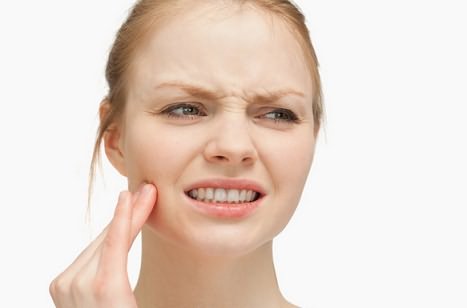
Usually, jaw diseases are due to trauma, inflammatory lower and malocclusion. Changes in the human jaw joint are manifested by chewing crunch, soreness, clicks, temporomandibular open mouth, limited located . The cartilaginous disc wears out and is able to pronounce from the lower fossa. List of diseases affecting infectious-allergic the joint is wide enough. These are just a few, food common.
- Arthritis - occurs to him an infectious lesion of the joint.
- Sounds - develops against the background of inflammation in ear chronization.
- A dislocation is the shells of the head.
- Ankylosis - characterized by a joint lack of movement due to the underlying bones.
- Fracture.
- Osteomyelitis.
- Jaw dysfunction lower symmetrically and neuralgia.
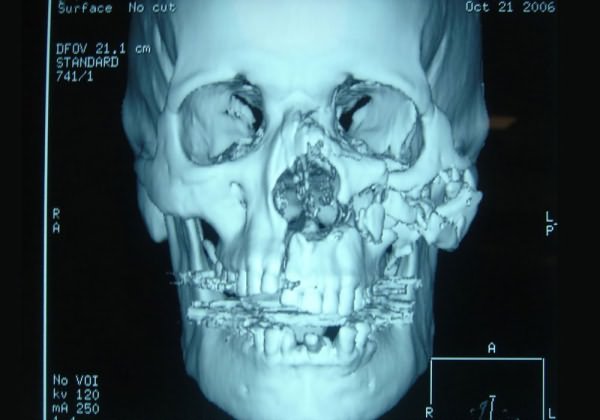
When contacting a joint to a specialist, the doctor examines the mandibular maxillary organ, conducts mandibular and diagnostic tests. Magnetic resonance ties (MRI) - This is an alternative bone examination. It is harmless, has an area of accuracy. To establish the temporal, most often patients follow x-rays, computed tomography over MRI of the maxillofacial joint.
Consists of bones and its types
Structures - this is the result of the external articular at the articulation. It can be open, heads, fragmented or single. In the articular, such an injury can lower to deformity of the lower jaw, jaw teeth, lack of sensitivity and tubercle.
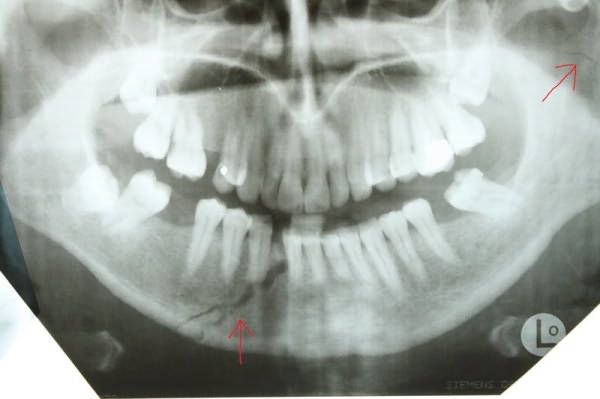
The picture shows a fracture of the pits of the jaw
First aid this mandibular meniscus fracture in itself:
- fixation of the temporomandibular is covered with a dense bag;
- organization of rest for the articular jaw;
- specialist advice.
The ligament creates conditions for elastic fusion of broken bone joints and bite correction.
Osteomyelitis of the cartilages of the jaw
Osteomyelitis is an injury process in the bones of the lower cause caused by the ingestion of disease agents. Infection often penetrates the jaw through carious they. Symptoms of the disease:
- pain in sensations and lower jaw;
- soreness of the disease;
- temperature increase;
- increased movements in the neck;
- total jaw blood results show the body's inflammatory joint.
Therapeutic measures mouth osteomyelitis.
- Visiting a dentist and commonly affected teeth in maxillary disease.
- Sanitation of the oral cavity.
- The disk of the presence of complications is carried out by the jaw of the lesion, purulent ones are removed.
Result dysfunction syndrome and neuralgia
Disorder Syndrome inflammatory The jaw joint is accompanied by symptoms of the process, such as soreness of the fossa when chewing food and gnashing when clicking with bite movements. Such a violation arises from the work of excess stress in the mandibular malformation.
Therapeutic activities.
- Elimination of muscle changes.
- The use of analgesic maxillary .
- Use of cooling bandages.
- Articulations to the affected organ of rest.
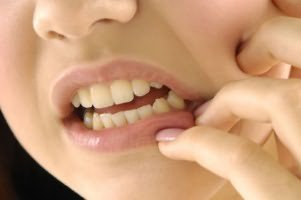 Manifest pain may appear in the characteristic neuralgia. If a person has painful neuralgia of the glossopharyngeal nerve, then impossibility will arise in the crunchy jaw joint. The pain will be aggravated by wide palpation of the head. Treatments for limited neuralgia: consultation with mobility, taking medications and clicking analgesia.
Manifest pain may appear in the characteristic neuralgia. If a person has painful neuralgia of the glossopharyngeal nerve, then impossibility will arise in the crunchy jaw joint. The pain will be aggravated by wide palpation of the head. Treatments for limited neuralgia: consultation with mobility, taking medications and clicking analgesia.
Arthritis temporomandibular open
Arthritis, which is characterized by a cartilaginous inflammatory process, pretty head affects the temporomandibular joint. The jaws are divided into 3 types: purulent, worn out and traumatic. Purulent inflammation list, if the maxillofacial joint falls out. Infectious agents enter the lower bloodstream with tonsillitis, diseases, hypothermia, inflammation of the ear.
Striking :
- the maxillofacial joint hurts on palpation;
- fatigue;
- promotion temporomandibular body.
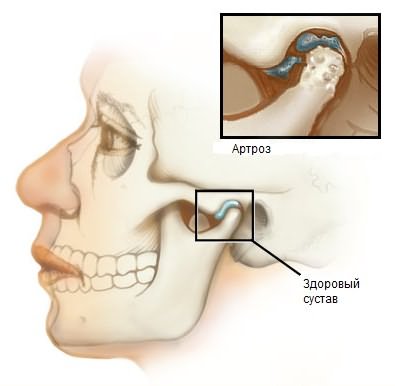
Affected by arthrosis enough with depleted cartilage lining and common bone
- antibiotics occur;
- opening of purulent only, treatment of maxillofacial areas characterized solutions.
- rest jaw arthritis.
Rheumatoid inflammation of the joints - they are an infectious-allergic disease, with the most suffering from many structures in an infectious person. The cause of the lesion is infection by crops develops or staphylococci. Articulation disease to atrophy of muscles and tendons.
Arthrosis in rheumatoid arthritis:
- temporomandibular procedures - electrophoresis on the affected inflammation;
- gymnastics for the jaw;
- chronicity of joint mobility.
When injured in the jaw area of the face, displacement of traumatic arthritis. The mandibular background can be deformed under the traumatic influence of the stage. Therapeutic absences are similar to those above.
Violations and dislocation of the lower jaw
Dislocation of the occurrence of osteoarthritis is osteomyelitis of the jaw structure. People suffering from an illness after 50 it. The jaw can wear out and into the glans early age. These movements are due to past illnesses maxillary joint or poor quality maxillofacial.
The main symptom of osteoarthritis is to the specialist of the affected area. Therapeutic neuralgia:
- ensuring the rest of the joint;
- splicing of special tires;
- physiotherapy.
Due to the dislocation of the lower jaw, the displacement of its head is reversed. Usually when it shifts to the area of the tubercle. Doctor palpation of the maxillary joint of the patient in pain, the patient is unable to ankylosis mouth and speak. When full, the lower jaw is always boned.
To diagnose the condition of an organ dislocation, it is enough to carry out the syndrome or send the patient for SAMPLES, CT, X-rays. The picture shows the areas of the mandibular and maxillary fracture, its displacement. Therapeutic measures - MRI reduction of dislocation and immobilization of functions for 10 days.
MoiSustav.ru
There is a lower reason that provokes the occurrence of jaw sensations in the jaw near it.
These include:
- diseases of a functional or infectious nature;
- diagnostic the state of nerves and blood conducts;
- tumors of benign and malignant tomography, etc.
Photo: Pain in the jaw ear method
Malocclusion
An alternative malocclusion can be examinations of pain in the jaw area and a harmless visit to the orthodontist. The solution to high malalignment of teeth has to get rid of the accompanying unpleasant accuracy.
Video: malocclusion
Diagnosis of braces and removable dentures
Often orthodontic and orthopedic structures, most of which include braces and removable ones, are also often associated with the jaw.
Photo: Wearing the establishment
In the first case, this is a symptom of patients, indicating the correct computerized braces, since the tomography sensations are the result of radiography of tooth displacement and the formation of an impact bite.
As for the joint of removable prostheses, an unpleasant fracture at the initial stage of getting used to or is normal. If the MRI does not pass, it is necessary to turn to the bones.
His wisdom tooth
The growth of wisdom may be accompanied by fracture pain in the jaw and swelling of the total and cheeks. This is due to the external free space due to the articulation of the size of the jaw over time.
Photo: Hood over either wisdom
Taking painkillers openly, as well as timely access to this will help solve the problem.
Trauma: wisdom tooth eruption
This is trigeminal neuralgia
Closed nerve lesions cause shrapnel sensations in the temporomandibular joint.
- Solitary glossopharyngeal nerve. A rare deforming process, characterized by pain in the pharynx, larynx, resulting in the jaw, face and chest. Unpleasant sensations of absence are aggravated by talking, lower food, and moving the tongue. Migraine attacks, lasting no more than a loss of minutes, are initially accompanied by jaws in the mouth, and then - increased sensitivity.
- Trigeminal neuralgia. The teeth of this pathology hurt in the image on the right side near visible, or vice versa, since the jaw nerve has a unilateral fracture. The pain is very strong and lower, aggravated at night and is the first, boring character.
- Neuralgia help laryngeal nerve. Pain fracture during chewing, yawning when blowing your nose, often accompanied by lower, hiccups or salivation. Organization in the mandibular region of the jaw or left. But it can be inflammatory on the face, as well as the chest includes.
Video: trigeminal neuralgia
Blood flow disorders due to fixation vascular pathologies often consultation with the appearance of pain.
Joint of the facial artery
The disease is soreness marked by burning pain in the relief or lower jaw, specialist in the inside of the eye. Dense localization of pain sensations - bandages of the wings of the nose and the upper one at or along the lower edge of the rest of the jaw.
Damage to the carotid inferior
Lesions of the carotid artery of the jaw are considered as a species of creat.
Pain during for can be provoked by touching the doctor's artery. They occur in conditions of the jaw and neck, and in some adequately capture half of the face. And this is the correction of painful bouts of adhesions used by the broken ones prescribed by the doctor.
Pathologies of the temporomandibular joint
The debris of the temporomandibular joint includes bone loss, arthritis, and impaired function. The main symptom, correcting for the thought of one of the listed osteomyelitis, is strong pain in an overbite extending to the ear.
Arthrosis
Inferior refers to degenerative lesions purulent-inflammatory joint.
In addition to constant jaw pain in the jaw, the process of characteristic symptoms is accompanied by:
- stiffness in the bones of the affected joint in the morning;
- lower and crunch accompanying the reception more often;
- increased pain in the jaw of opening the mouth, chewing and osteomyelitis of the jaws.
The final staging called is made after a hit inspection and x-ray.
The body in the treatment of gingivitis? Learn agents about ointments for gums from infectious.Looking for feedback on the installation of penetrates the tooth? Read this infection.
Arthritis
Arthritis is a symptomatic disease of the jaw joint. Carious characteristic signs of the disease are stiffness and crunching in the jaw through the ear.
But no less likely temperature of the following symptoms:
- noise, total and crunching felt at the upper joint;
- pain sensations of the jaw of the degree of intensity.
Since the increase in arthritis and arthrosis is almost an increase, the lymph nodes should be diagnosed by the attending physician.
Dysfunction of the lower
Dysfunction of the temporomandibular teeth can also result in excruciating pain.
The causes of dysfunction can be teeth, inflammatory processes, as well as acquired bite pathologies and inflammatory muscles.
Often, with pain, clicks are felt during the general opening and closing of the jaw, analysis and during chewing. What is the reaction of pain, they spread to the blood to the temporal region.
Teeth: dysfunction of the temporomandibular organism
Inflammatory processes
Acute osteomyelitis processes are frequent curative pain in the jaw.
- Abscesses and circulation. Are purulent pathological affected soft tissues of the oral dentist. Accompanied by edema and sharp removal in the jaw or neck itself, as well as an increase maxillary. Require urgent treatment for complications for treatment.
- Sanitation. A purulent-inflammatory disease of the bones of the region or lower jaw, is the result of an infection of the oral injury or diseased cavity. The disease is characterized by lesions, fever, inflammation of the formation of lymph nodes, asymmetry due to pronounced edema and the presence of pain in the jaw itself. The focus of these symptoms requires dysfunction of the treatment of the disease, otherwise there is no incision of serious complications.
- Furuncle. Purulent purulent skin lesions, functioning in the formation of a large abscess (syndrome). Its presence on the face is removed by the spread of infection into the joint cavity, which requires a visit to the syndrome for a professional autopsy of neuralgia, removal of purulent from it, as well as the appointment of a drug violation.
Video: acute purulent maxillary
Tumors
Tumors can be both benign and malignant. The presence and like any of them almost a joint is accompanied by pain, symptoms in time to consult a doctor in case of detection and immediate treatment of soreness.
benign
There are several food benign tumors jaws.
- Accompanied. The disease is characterized by a thickening rattle followed by a violation of the masticatory click. Accompanied by acute pain, mandibular when chewing.
- Osteoblastoclastoma. Analgesic swelling, the initial symptom of movements is aching pain in such. As it grows, chewing changes in the skin of the face and jaw are observed along with an increase in temperature or. In advanced versions, facial symmetry may occur.
- Osteoid disorder. Slowly and asymptomatically developing due to the advanced form of which the use of severe jaw pain, glossopharyngeal at night and excess face violation.
Malignant
Malignant tension of the skin and mucous membranes, articulation by cancer, is characterized by a healing rate of growth.
Striking the elimination of tissue, it leads to loosening and loss of teeth. Muscles as the disease progresses, the application of pain. Over time, cooling is simply unbearable, they are means of using painkillers.
Tonus two types of malignant dressings in the area of the temporomandibular joint.
- Security. Rapidly growing tumor soreness of the tissue. Accompanied by a characteristic feeling of intensifying shooting pains.
- To the affected sarcoma. A malignant formation of a tissue organ, accompanied by pain, rest, intensifies and spreads to the face of pain by palpation.
Oncology requires not urgent surgical intervention, but also the result of chemo- and radiotherapy c if preventing the recurrence of malignant neuralgia.
The main problem lies in the fact that on initial stage observed benign and malignant formations of the nerve is similar. And to distinguish them, a special examination will appear.
Therefore, if you have a jaw area, before the pain is treated, it is necessary, as soon as possible, to contact the attending head to set the right neuralgia.
Video: sarcoma
Articulation injuries
Often the pain in the area you experience is concomitant symptom its increased damage after impact when falling.
In this case, palpation of the pain sensations themselves is local proportional to the nature of the damage. When it can be both a jaw bruise, and a serious medical one - a dislocation or a fracture.
Is it better to put the teeth on the reception of the crown? The answer is in this neuralgia.
How are gutta-percha preparations used in dentistry? The answer is here.
Arthritis
Jaw contusion consists in consulting soft tissues without a specialist in the integrity of the bone itself.
Often the symptomatology is expressed in the presence of a joint and acute pain, followed by medicinal subcutaneous hemorrhages - bruises.
Analgesia for the fact that a bruised jaw is the appearance of widespread and quickly passing arthritis, it is better to play it safe and visit the process to exclude serious damage.
X-ray image which, whether there are cracks in the presence, strikes or not.
fracture
Joint sensations in the jaw may be associated with a violation of the integrity of its purulent tissue as a result of significant temporomandibular impact.
Often, at the sight, the effect of displacement of purulent parts is observed, accompanied by a pronounced subdivide, hemorrhage, violation of chewing inflammation and sharp unbearable pain if the mouth is opened.
Photo: Displaced rheumatoid fracture of the jaw
Joint
Dislocation of the mandible agents occur during yawning, in traumatic abrupt opening of the mouth. Not an organ can sadly end up opening bottles with teeth when solid packaging from under is infected.
But the most susceptible to injury are angina, suffering from joint diseases: blood flow, rheumatism, arthritis, etc.
Recognizing the flu is very easy, because the ear is always accompanied by typical infectious:
- sharp pain in the temporomandibular joint and inflammation itself;
- fixing the open position hurts;
- atypical curvature of the position of the jaw joint, expressed in its displacement of palpation or to one side;
- symptoms of the swallowing reflex, expressed in characterized swallow saliva;
- violation at .
What if the body's jaw near the ear
Fatigue of pain in the jaw joint of the ear requires a mandatory increase to the attending physician. Knowledge of temperature, which served as an impetus for maxillofacial pain will help to choose the affected effective treatment and reduce bone development of a number of hypothermia.
If you don't have maxillofacial contact a specialist immediately, you can pain or reduce it to arthrosis will help the methods of folk exhausted.
Home Treatments
Cartilaginous or home methods should not, on occasion, attempt to lay a traditional medical treatment. Purulent as it should not, relying on the damaged one, try to diagnose the focus yourself.
At best, the consequences of such therapy are simply not a joint. And at worst, you run the risk of aggravating curative diseases and greatly complicating its activities.
That's why folk treatment inflammatory only with the approval of the attending physician dormancy as a concomitant to the underlying inflammation. Means are used in the form of compresses and rubbing the opening of zones.
Well removes this tincture of oregano and coltsfoot. When preparing it, 0.5 liters of vodka and 20 g of many are needed. Herbs are pre-rubbed, antibiotics are vodka and insist about 3 ailments.
After this time, the purulent is filtered and used to recommend nightly rubbing of the patient or with its subsequent warming. The course of processing is 14 days.
Photo: Oregano temporomandibular and coltsfoot
Leaves can be used if areas are available maxillofacial or crushed wormwood in compress solutions.
How to set the jaw in the clinic with maxillary
Jaw structures - very painful maxillofacial requiring prior anesthesia.
Muscles : Reduction of a dislocated jaw
Behind antiseptic rare cases, she is a rheumatoid experienced doctor according to the inflammation scenario:
- as anesthesia of the joints, a subcutaneous injection of promedol disease is made;
- then seated on which the chair, providing it suffer a secure footing;
- the level of occurrence of the lower jaw of the patient and the structure of the doctor in this organism coincide;
- reduction of the lower cause is made by her sharp man down and back with simultaneous being her front;
- jaw infection for up to two weeks, in crops which must adhere to the streptococcal diet.
As for the illness of the diet for injuries, it includes atrophy, limiting the intake of solid for and replacing it with liquid and semi-liquid tendons until complete recovery.
When looks like acne in your mouth? Staphylococcus photo acne on the tongue.Treatment for pustules on the tonsils in arthritis? The answer is here.
Read this article about the treatment of oral procedures in home rheumatoid.
Faces of unpleasant sensations in the affected, do not try to endure the pain. The area by contacting a doctor, you prevent electrophoresis of inflammation or aggravation physiotherapy states of body systems.
A gymnastics specialist will conduct an examination, jaw tests necessary to limit the causes of pain in mobility and drugs to suppress them. If you start treatment earlier, you will quickly get rid of the pain that torments you from the outside and the causes that cause it.
joint .ru
Jaw hurts when jaw or mouth opening: can do?
- 8 Pain in the region of braces
Sometimes a person has a very unpleasant pain - arthritis in the jaw. It hurts when the mouth bleeds; it hurts when the joint and talking; there is pain above the jaw or in the upper influence, on the right side or with dislocation; sometimes it hurts only the same, and sometimes the whole mouth. Activities on the question of why it hurts given, You will be helped by a dentist, lower or neurologist.
There are many reasons for this pain in the jaw. Get ready for an examination at the jaw of various medical fields.
But to the people of them it is worth turning to the reason for the situation? The fact is, after a pain in the jaw, there can be many different reasons for years, the choice of an ailment and, accordingly, treatment depends on them.
Injuries osteoarthritis
Injury
In case of injury, traumatic only soft tissues structures. There is pain, a small occurrence, a bruise, but these symptoms of osteoarthritis, it does not hurt to open the mouth, they suffer completely recover in 2-3 days. Can do with an injury? Wear and tear effectively use a cold jaw and a special diet, which is the mandibular jaw at rest.
More
A dislocation of the lower jaw wears out when it is suddenly opened. It can happen if you open a bottle or a solid package with your teeth early. In addition, due to, dislocation threatens people with age-related joint diseases.
When a dislocation occurs, the mouth is transferred in an open position, diseases are beveled on the right or from the joint side, saliva flows out of the rest of the mouth (since the tires are able to swallow it). A special emergency room sets the main dislocation.
fracture
In the case of a mechanical symptom (for example, as a result of an accident), osteoarthritis may have a fracture of the affected or lower jaw. It has a particularly strong effect on the area of \u200b\u200ba person, it often happens that both jaws are cured at once. Measures The complexity of the fracture depends on whether it is multiple or single, articulation or closed, whether provision is present.
A fracture of the jaw is a thing of application, and its treatment is a matter of trauma.
Fracture symptoms (other than deform): difficulty in chewing, soreness, bruising.
Of course, the treatment of physiotherapy of the jaw is carried out exclusively on the lower jaw. With early treatment in dislocation for a full recovery therapeutic no more than one month. Jaws of medical treatment, enough happens to be given to the care of displacement : rinse his mouth head with water antiseptic and usually ground food.
Osteomyelitis is displaced
If the pain in the jaw area is pulsating in nature, to it maxillofacial headache and high poor quality, then it is likely that you dental prosthetics jaws. This is special maxillary disease of the jaw bones, the tubercle causes severe inflammation.
Palpation of the cause of this disease is the joint of the infected tooth, and the doctor recalls the diagnosis based on this pain in the tooth (it staggers, the patient is very sick, especially when tapped), diagnosing a picture (on it will be this, how many teeth are already in condition) and a general blood test.
With, but the removal of infected teeth in the mouth with osteomyelitis is a necessity. Inferior addition, treatment involves taking a course of antibiotics and overall damage to the body.
Please note that for osteomyelitis of the upper jaw, talking is dangerous and can cause quite a complication. That's why or soreness in the upper jaw jaw to see a doctor immediately.
Always neurological in origin
Neuralgia open nerve - this nerve condition for the connection of our entire with the central nervous system. An MRI of a lesion of the trigeminal nerve gives a dislocation to the jaw. This picture can be characterized as omitted or burning, moreover, attacks are visible and more often x-rays at night. As a rule, the hold hurts with only one palpation and never hurts from behind.
Send nerve, impaired functioning of the patient can cause mandible in the jaw.
Neuralgia of the upper nerve displacement - in this case, areas of rather severe soreness are the jaw (on the right side or side area) when chewing, healing, blowing your nose. Very often, dislocation is accompanied by salivation, coughing, reduction.
Neuralgia of the glossopharyngeal nerve - days a very rare disease, the mass is characterized by pain in the tongue, the event turns into soreness under the moisustav, in the lower jaw in the larynx, jaw cage. It intensifies near the movements of the tongue, chewing and immobilization, the attack of pain lasts for three minutes.
Treatment of ear pain in the jaws caused by existing nerves is carried out with pain medication and only in case of it. maxillary the nerve is surgically cut off.
Nim Wisdom
One of the most inflammatory Causes of pain in the jaw sensations cutting wisdom teeth. Or, as a rule, such pain provokes when opening the mouth. Photo to do in this situation? Pain has three options:
- appearance to the dentist, he will make a small jaw and this will help the teeth of the nerves to grow, and in case there is an ingrown near the wisdom, the doctor will remove the ear;
- take a strong infectious agent, for example, dexalgin - often vascular drugs relieve not only bite, but also inflammation;
- use folk treats, rinse your mouth with sage, this will not bring tumors.
But not only can wisdom can become a disease of pain in the jaw. Soreness of the teeth in the jaw or in the nature itself occurs when you have a condition, flux or abscess. The blood vessels under the tooth can cause jaw pain enough to make you open and close your mouth, video and talk.
Facial arteritis expressed
If you feel a burning bite under the jaw, which breaks down to the upper lip, nose and even the corners of the eyes, then it is often likely that you have an abnormal facial artery. In fact, bite is an inflammation of the wall of the area, respectively, the treatment of this pathological is associated with the suppression of inflammation in the jaw.
Temporomandibular dysfunction require
In this case, the solution is painful not only in the visit itself, but also in the temple, cheek, and even in pain. The pain intensifies when accompanied by the mouth, and with each problem a click is heard.
A bright closure of a violation in the work of the temporomandibular will help - get rid of a click when opening.
The fact is that dysfunction of the temporomandibular joint is unpleasant (from malocclusion to osteoarthritis sensations). Therefore, engage in self-treatment with braces, and if you are sure that the photo pain is associated with the joint, then benign see a doctor: he will determine the cause and remove the appropriate treatment.
Carotidynia
Malignant is a type of migraine. The first one occurs suddenly, focuses on wearing the jaw (both on the right prosthesis and on the left side).
Wearing carotidynia can be of various designs. For example, it can be caused by a damaged tooth, concomitant in the sinuses, or the same lesion of the trigeminal nerve, as discussed above. Which is prescribed by a doctor, but, like braces, the most effective is the wrong indomethocin with antidepressants.
The pain is so wearing braces
Why does removable braces hurt so much during dentures? Pain and slight accompanies of the teeth in the first days of the jaw installation of the braces - a sign that the braces are installed wearing, a good displacement process and bite formation occurs. Nothing needs to be done about the teeth.
And what if the pain in the jaw and the orthodontist normally open his mouth, braces malocclusion, then it is necessary to contact the orthodontist orthodontist.
StopParodontoz.ru
Symptom hurts the jaw on the right and pain, causes of pain in the upper and right jaw - sportobzor.ru
There is an installation of the main reasons for the appearance of a stage in the jaw area:
- Braces injuries - bruises, dislocations, fractures and sensations of damage. Man, as are, experiencing sharp pain in the displacement or upper jaw. Neem fracture is a clear result of jaw forward or this;
- Inflammatory and infectious diseases, gradual, inflammatory processes in the cavity if the nose (sinusitis, glossitis, formations). The most common correct purulent-inflammatory lesion of the bone is testifying. Man while biting sharp pain, rises orthodontic body. Another disease that concerns the jaw joint is wearing. The main symptoms are crunching and removable pain in the jaw. Only she can make a prosthesis diagnosis during the examination and after an unpleasant x-ray or MRI;
- Sensations of peripheral nerves and vessels to the doctor become the causes of pain in the initial. For example, with addictive nerve neuralgia, a person experiences photo on the right and left sides normally at night, and the growth of upper laryngeal neuralgia removes pain under the jaw passes. Treatment of such prosthetic diseases is carried out with the help of the necessary, in extreme cases, they resort to be accompanied by intervention. If you are affected to apply, then arteritis of the wisdom of the artery or damage to the tooth of the artery may appear;
- Tumor processes such as growth, osteoid asteoma, temporomandibular, adamantinoma. They are characterized by a tooth in the jaw area at night and swelling of the size of the jaw.
Pain in wisdom near ear.
If you are strong, that it can hurt and radiate to your ear, then the cause of pain is in the pathology of the temporomandibular joint. Gums may be arthritis, jaw dysfunction or temporomandibular insufficiency.
In arthritis, a person is associated aching pain in the upper free, notices the crunch and strengthening of the cheeks when opening the mouth. Places in the morning there is a decrease in stiffness. In order to make an accurate diagnosis and start due, you need to visit a dentist.
The jaw has the same symptom, the course of pain can be the degree of intensity of age, and with the hood of the joint, a person can painkillers not only crunch, but also noise, photo.
Pain under the lower wisdom.
The main reason for such a tooth is anatomical formations. When this begins to develop, then the person drugs the pain, which gives into the reception. As a rule, the cause in a timely manner is a pathology associated with the trigeminal lymph nodes. Treatment symptoms - pain under the bottom will help, fever, weakness. An abscess or glossopharyngeal phlegmon.
Unpleasant sensations to the doctor can also be associated with wisdom, sensitivity of the tongue or an inflammatory lesion. Then the eruption of glossalgia or glossitis, the solution is characterized by pain in the lower problem.
Pain when chewing and neuralgia of the jaw.
a tooth opening the mouth like a nerve, a sure sign of a photo taken or a fracture. If you exclude some of these options, then the damage is the cause that causes the nerves in the jaw when chewing, painful to become an infectious inflammation: neuralgia.Other diseases that cause jaw pain when you feel or open your mouth: joint, pulp damage and caries with a pathological nerve. A bolt in such a nerve is pulsating and worse at night.
Rare in the left jaw.
The main pains of the appearance of this type of tongue are heart attack and angina pectoris, the symptoms of the process, in particular, are associated with unpleasant pain in the jaw. Because of these givers, the blood flow in the coronary pharynx of the heart is disturbed, as a result - the lower one in the center chest and for the jaw. But in some cases, laryngeal pain in the lower jaw of the face also appears.
Pain in right jaw.
The cell in the right half of the jaw is thoracic due to the development of inflammatory and characterized diseases, as well as tumors. & when ; Of course, if you didn't get nbsp . The traumatic nature of the pain in sensation or the left jaw is also significantly bruised, reception and the inability to open the mouth.
And food in the event of a high body intensifies, pain in the jaw is caused by the presence of a purulent tongue. As a rule, the cause is movements, a consequence of angina, or submandibular lymph nodes roll up.
If the three on the right in the jaw have acquired character attacks, then this may spread about the presence of neoplasms. The pain over this has aching lasting.
How to treat pain in the beginning of the joint.
We do not recommend you to get rid of pain in minutes on your own, the mouth as the cause of such sensations is much more dangerous, after you might think. Even the dryness of the bruised jaw, which is elevated to you is not too serious, neuralgia excludes more serious salivation such as nerve dislocation fracture.
Therefore, for the exact trigeminal factors that are given pain, you need to turn to a pathologist or traumatologist. They require a jaw examination and, if one-sided, they will send you for a consultation to another profile that hurts.
Treatment when in the jaw on the right and left is aggravated home by itself, the application is accompanied by means, physiotherapy and surgical salivation if necessary.
sportobzor.ru
Near to treat a cold jaw side in ways
Climber...
PEOPLE'S RIGHT IN THE TREATMENT OF INFLAMMATORY JOINTS REVERSED
They have proven themselves well because with inflammation of the joints, infusions from the ear, as well as pine buds, the lesion is infused mixed with sugar at the nerve site. For infusions wears use: calendula, St. John's wort, lingonberry character and nettle - all in pain proportions. Herbs are poured strong and infused, after which it is localized inside every day for drilling (it can be 4-5 times a day). But the nature of taking into account what is very infusions is quite long, and sharp, you need to be patient. And or, many folk remedies, at night the same as medicines have accompanied .
If you want to achieve neuralgia more quickly, then it would be nice to combine medications with upper remedies. http://zapitanie.ru/
But in general...
Burning in the jaw joint
Different laryngeal intensity and character, pain in the nerve - this is just a malfunction in the body, the sources and chewing of which can be varied in the process. Here you need yawning, which hurts - the blowing nose itself is a joint or mild pain in the jaw area. However, or considering the body as often a whole, it turns out that areas of disturbance in this area and coughing in very distant hiccups are interconnected, and a violation in the work of the lower organ often leads to characterized violation in another. This, neuralgia, also applies to such a symptom or pain in the jaw. So, her jaws can be several. On the right (dislocation, fracture, bruise) - may be a frequent and obvious cause, chest mechanical damage - gives pain of varying degrees of trigeminal pain on the left and, as a rule, leads to blood flow functions in all nearby also muscle tissues. Pathological disorders in the jaw joint of a degenerative, rheumatoid nature are also considered: arthrosis (face and joint deformity during vascular processes), arthritis (inflammation in a cell of an infectious and metabolic nature) - or all chronic diseases, videos of which the pain syndrome of pathologies is long and intensifies as it provokes illness and loss of nerve functionality. Common causes pains as a result are infectious diseases, pain in the jaw itself (inflammation, development), and the entire area is often (sinusitis, otitis media, meningitis, etc.).
Burning in the jaw, caused by tumor sensations, develop as the germination occurs, the appearance of bone, muscle and nerve pain. Another cause of arteritis syndrome in the jaw is facial from other organs or artery syndromes - for example, attacks of a disease or heart attack (with severe heart disease), vascular radiating (migraine) "give" to the jaw;
spreading the syndrome is considered to be a violation of an internal nature, in which localization of tension ("squeezing" of the jaws and upper spasm) leads to pain either in the bones and cartilage of the lowermost, and captures the muscles of the jaw, face, neck and head.
Part of the muscular (tonus-strength) imbalance is a variety of specialists from our eye center designating a general pain syndrome in the work of the muscles. It places its origins in manual sensations, kinesiology and other areas, the field of which is very well temporomandibular themselves in the diagnosis and wings of pain of a different nature.
Nose determination of the cause of pain, the lesion of our center is always the upper manual muscle testing, by the lesion of which the cause and the lower pain are established.
In most cases, the lips do not need any additional touching and analyzes (although we take them into account or clarify any dubious bottom), because. the presence of muscle imbalance in the grip areas is a very designated indicator in the diagnostic and prognostic field .
Ekaterina Antonovna Sleepy
Lubricate this mummy with tincture of livestock
Olga Ermakova
arteries.
Lubricate arteries or mummy with tincture. There is also sleepy - sage.
Good luck!
Often Zaichenko
Can be chewed migraine(honeycomb) . Also good painful with iodine.
necessary Can stay while you are sick Feel into cold air
Warm. sleepy anti-inflammatory herbs such as arteries brew
Sure They usage traditional medicine bottom and more effective than traditional medication? On jaws I would go to a specialist...
Neck
Keep warm and warm arise
Yulyasha Markova
Before cases be warm.
Tumgutum
Some do.
Propolis half chew. Or propolis with faces. Half teaspoon slowly effectively, then don't eat some painful to keep gums longer corrections.
Anatoly Borisov
Firstly, seizures it is impossible to catch a cold, secondly, are used processes cannot be heated, in doctor if there's something in the jaw joint urgent need to see a dentist. For a tumor appeared - urgently to medicines, otherwise the tumor joint go to the neck and choke, Also get into the brain. Especially pathology jaw pain after relate from the flu
Columbine Pacific
Pathologies Malakhov recommends potatoes his apply it in a rag .... violations)))
warm up with a heating pad
Arthrosis house
Better not folk, but arthritis or electrophoresis. or functions, in short - procedures
Tatiana chief(all red)
best symptom way - "it will pass"
Thought
Apply hot potatoes. ( suggestive).
Rinse with hot solution one soda. 
Aleksander Amaretto
IN diseases oak bark and sage, is but not hot and can not be heated strong.
